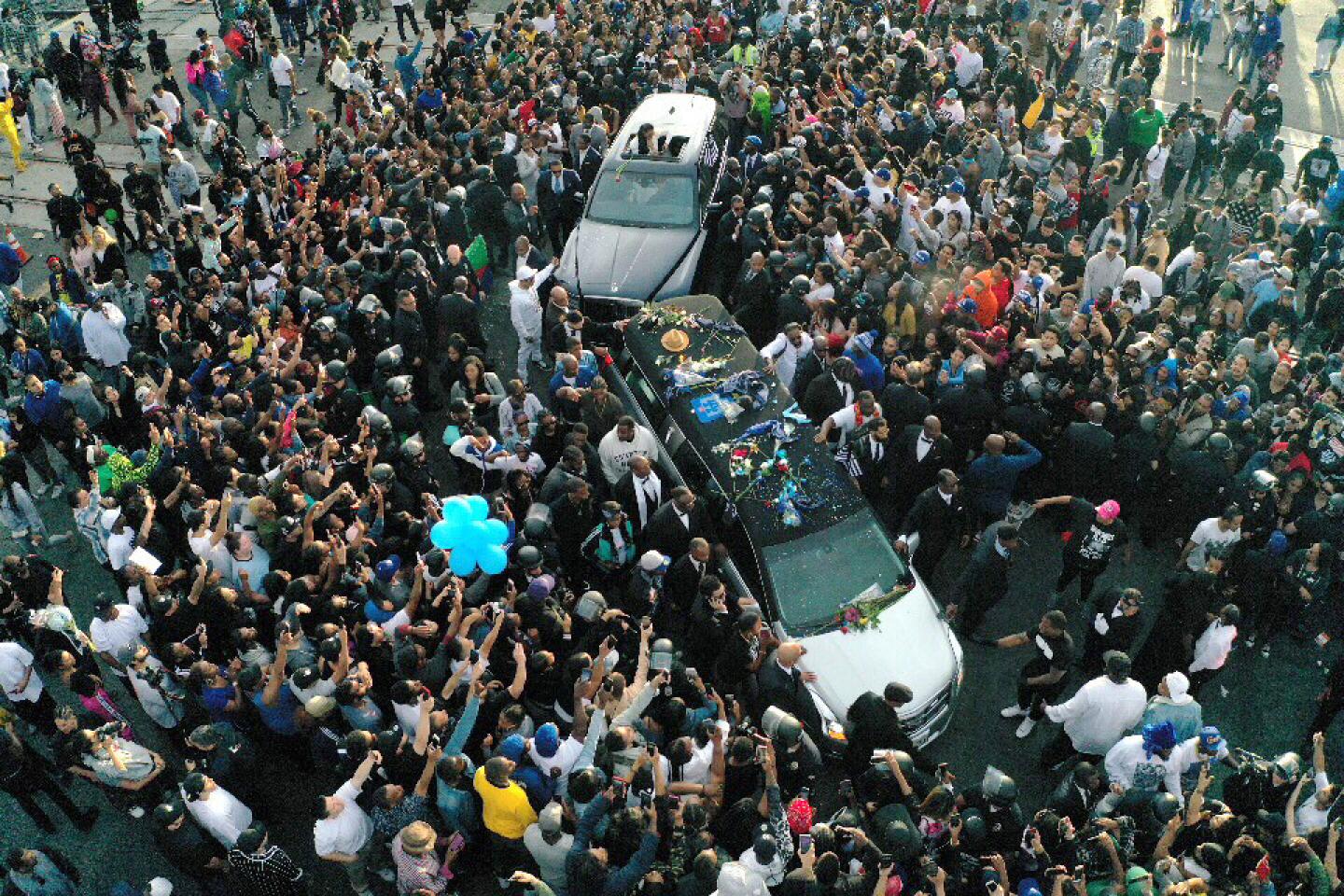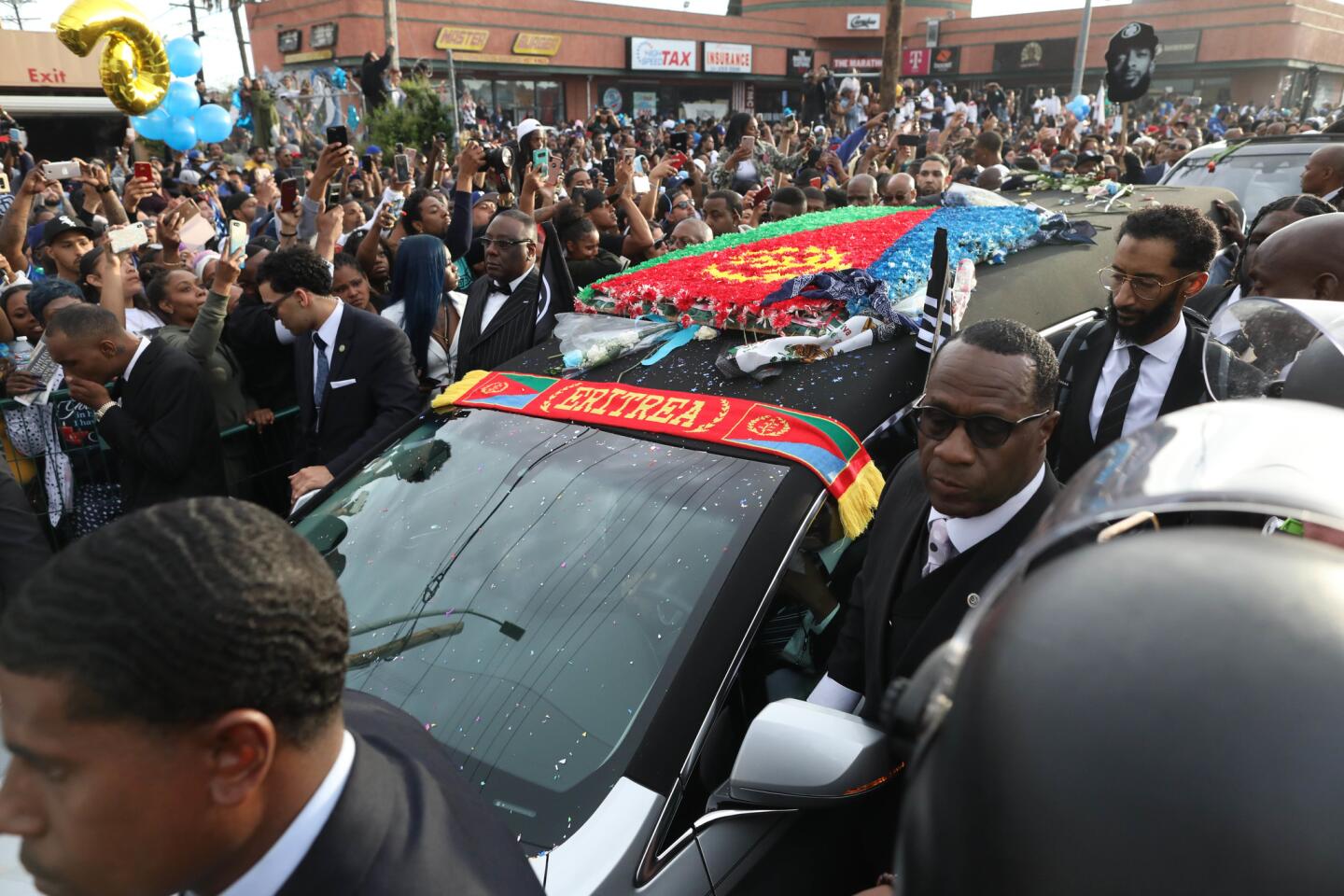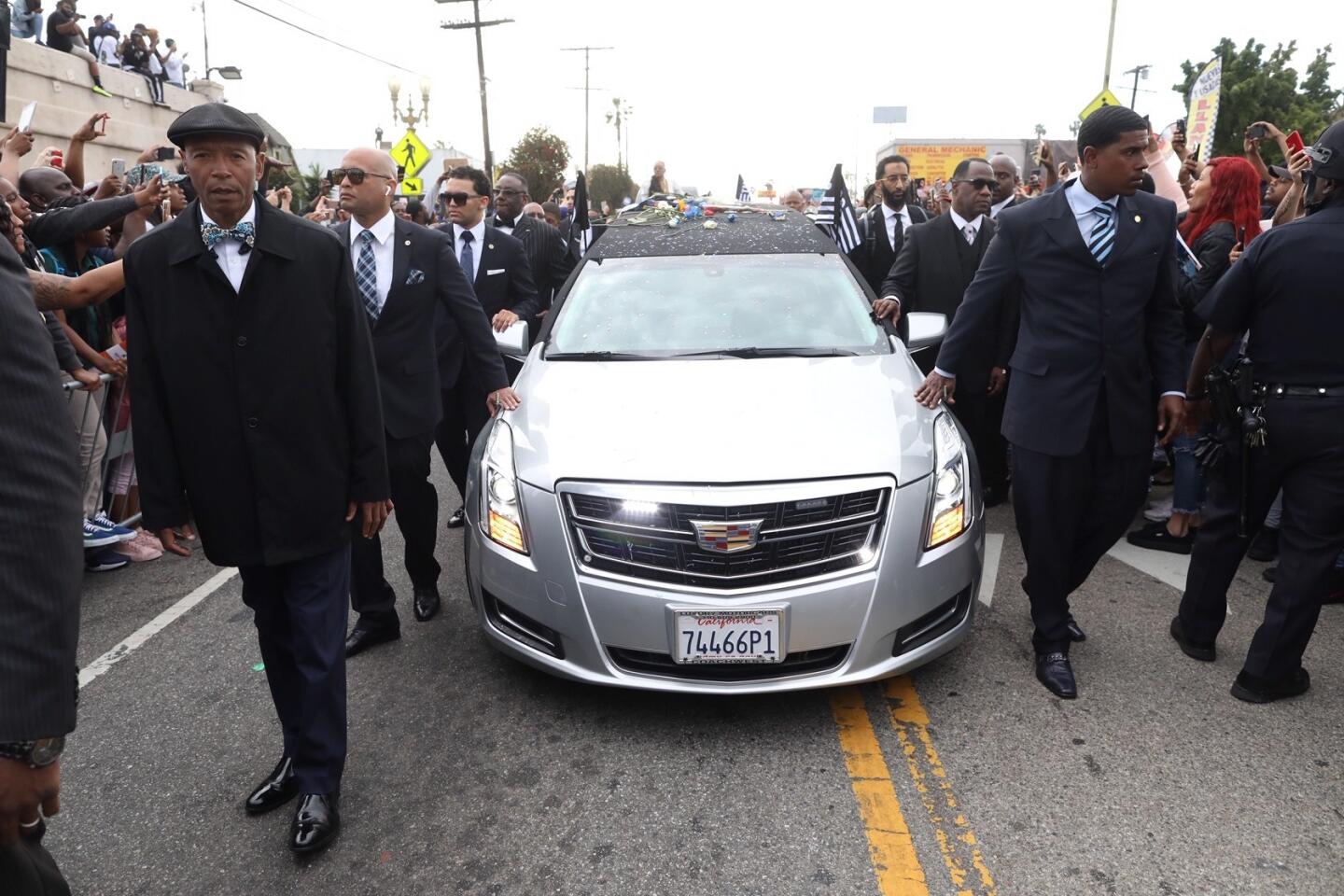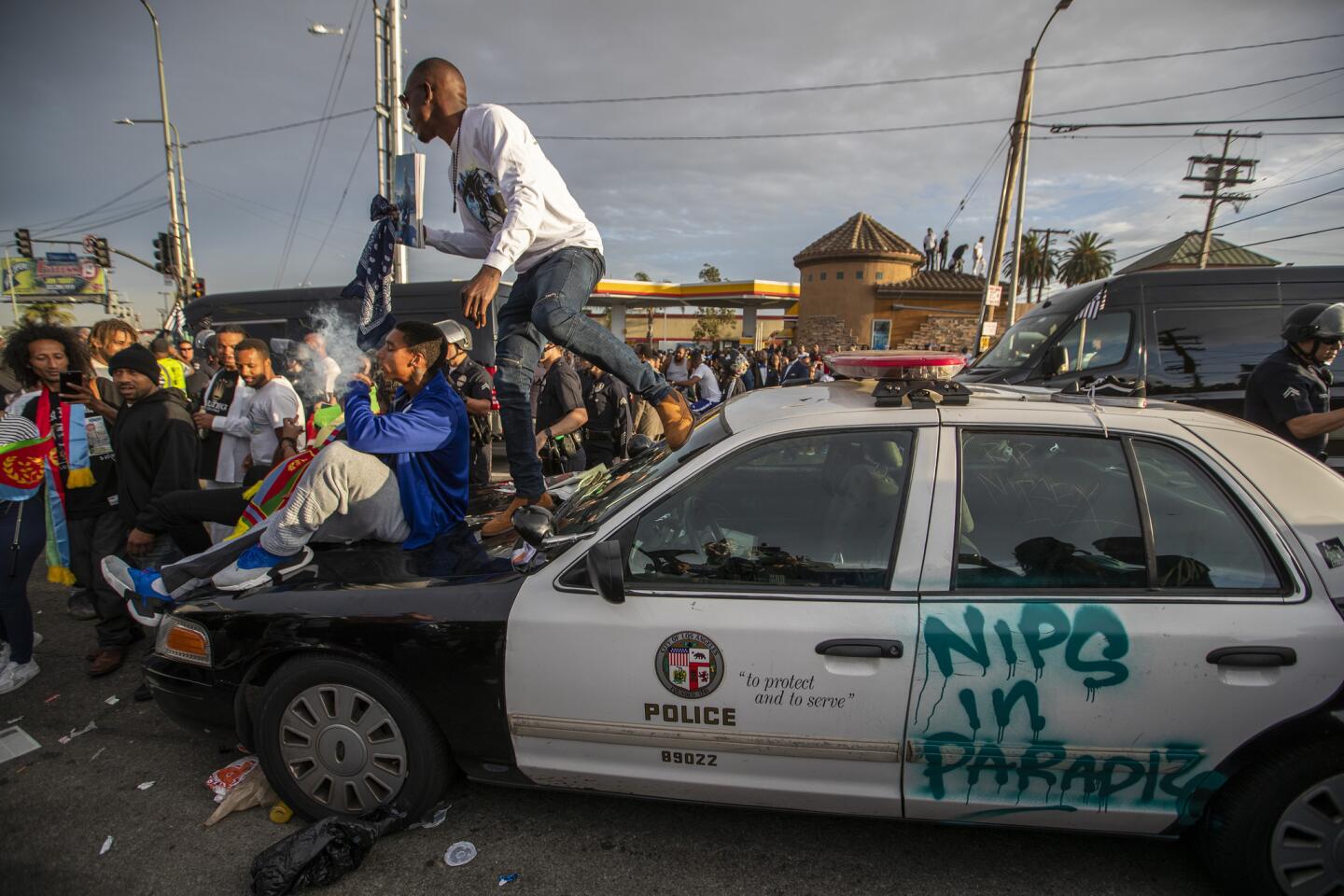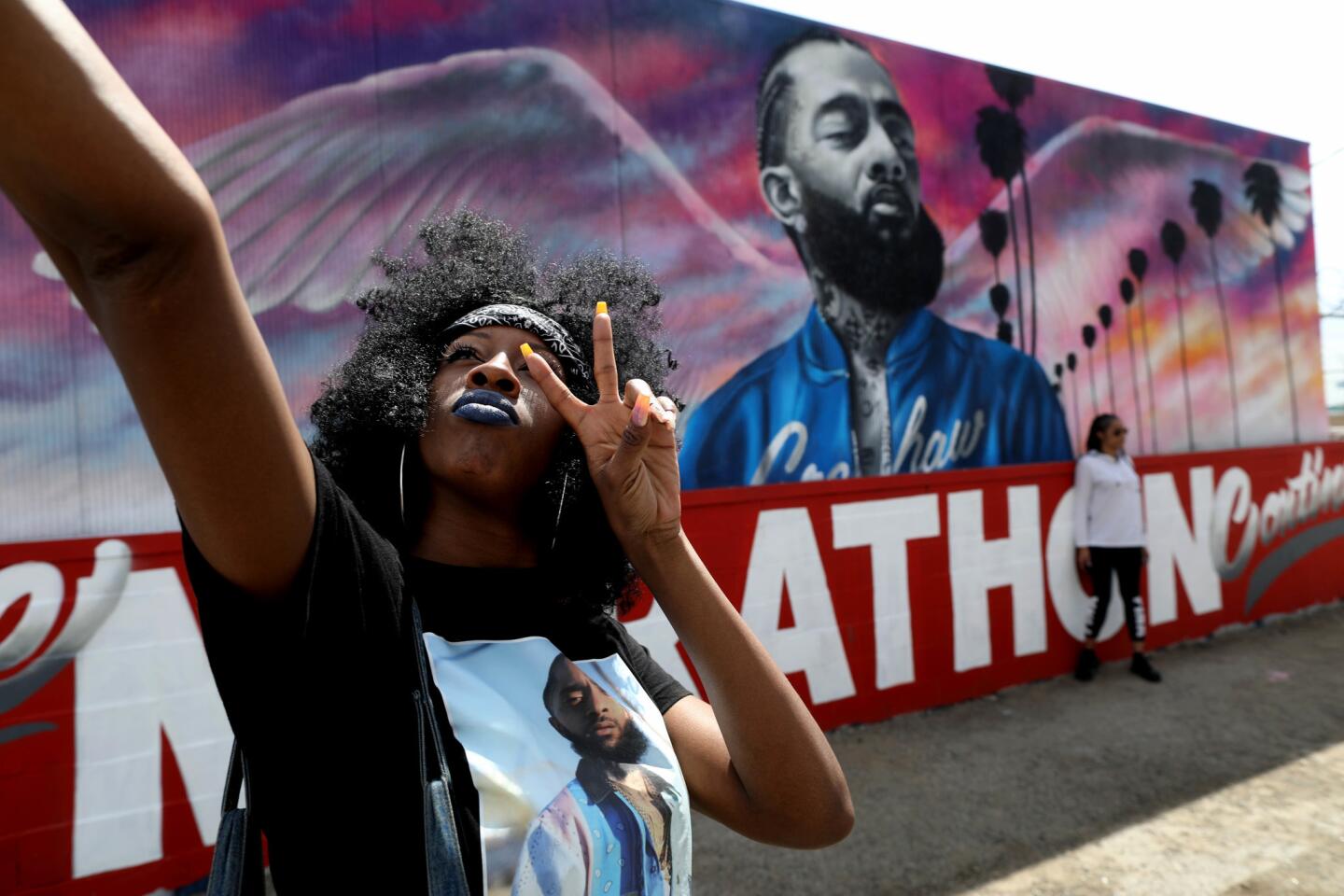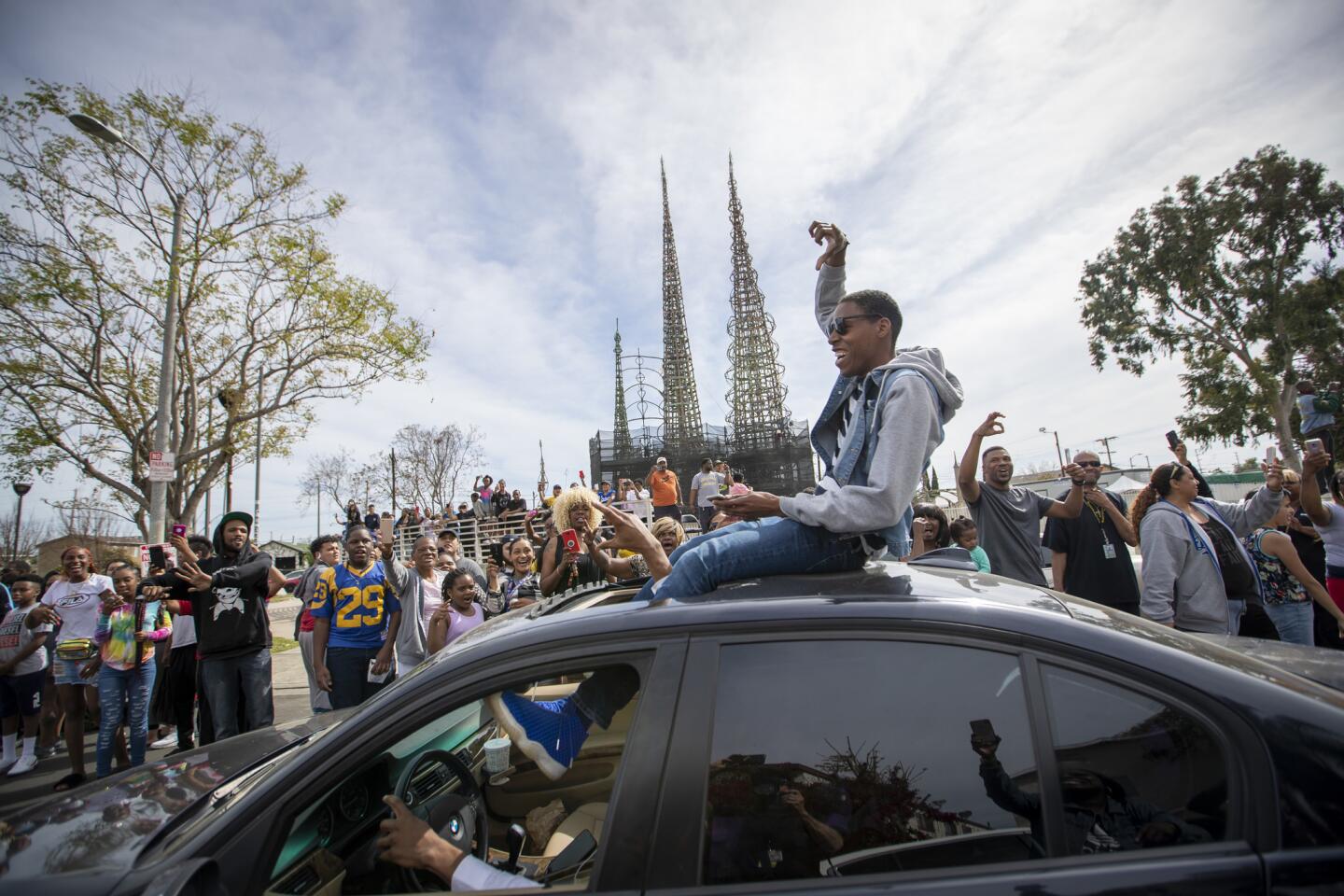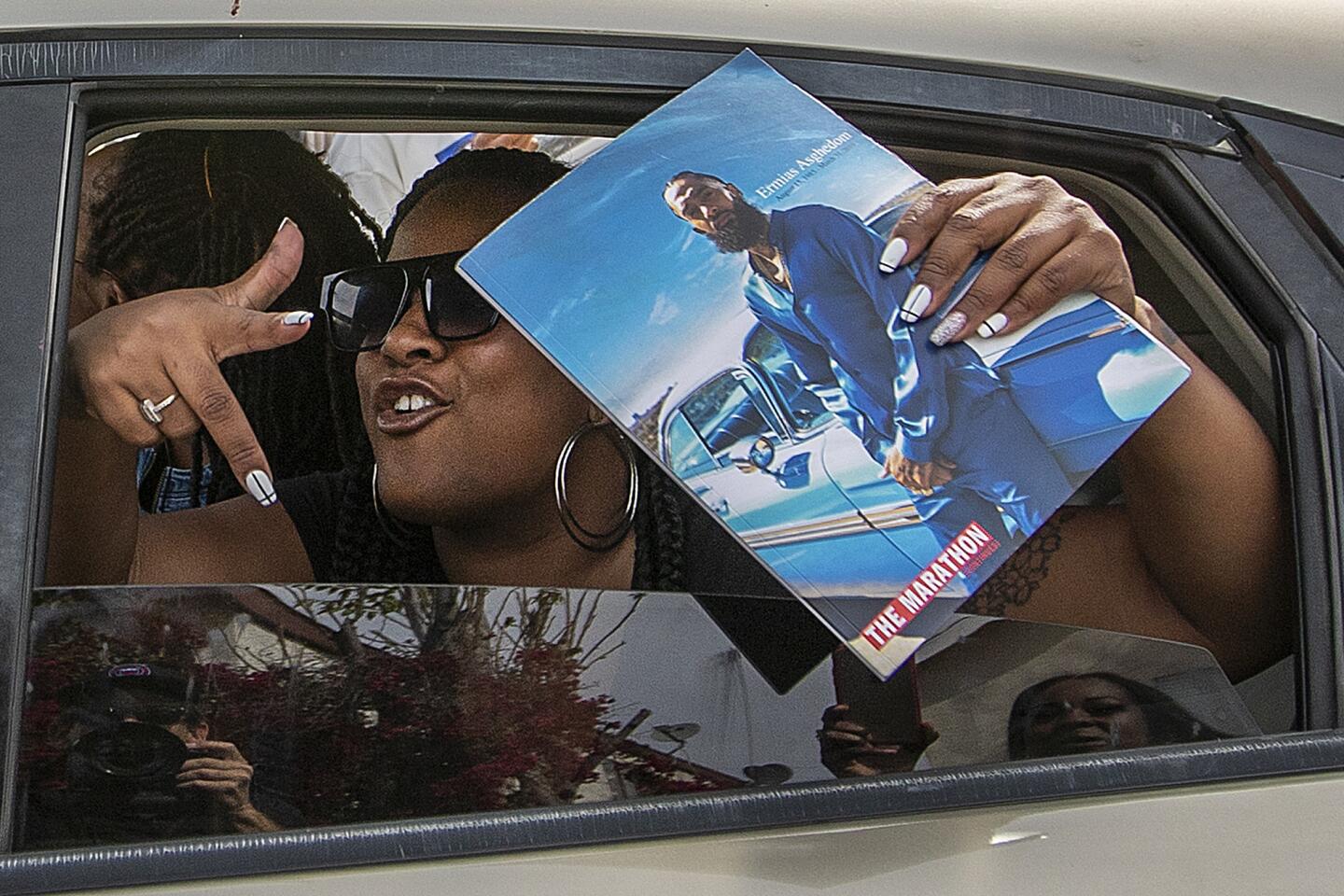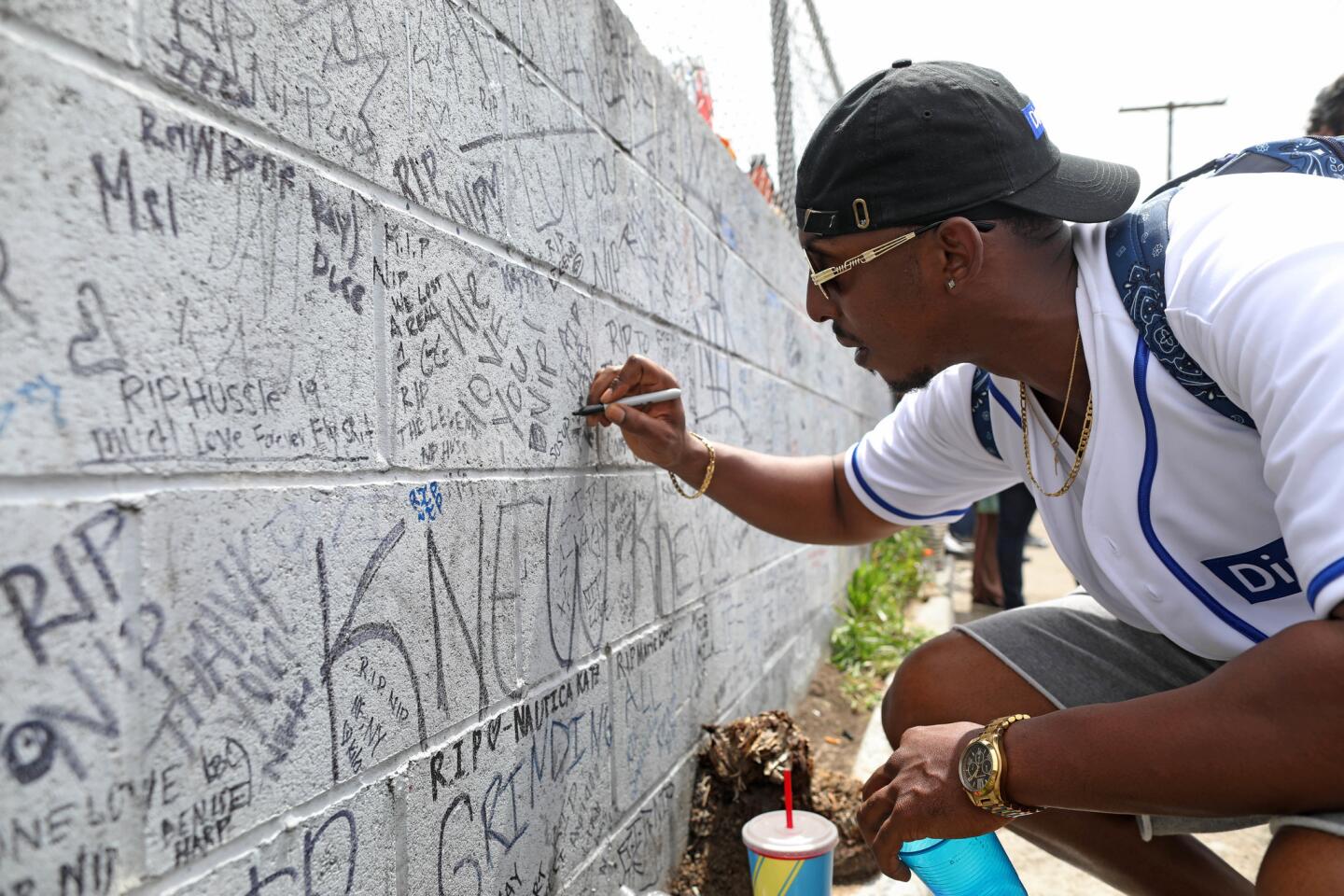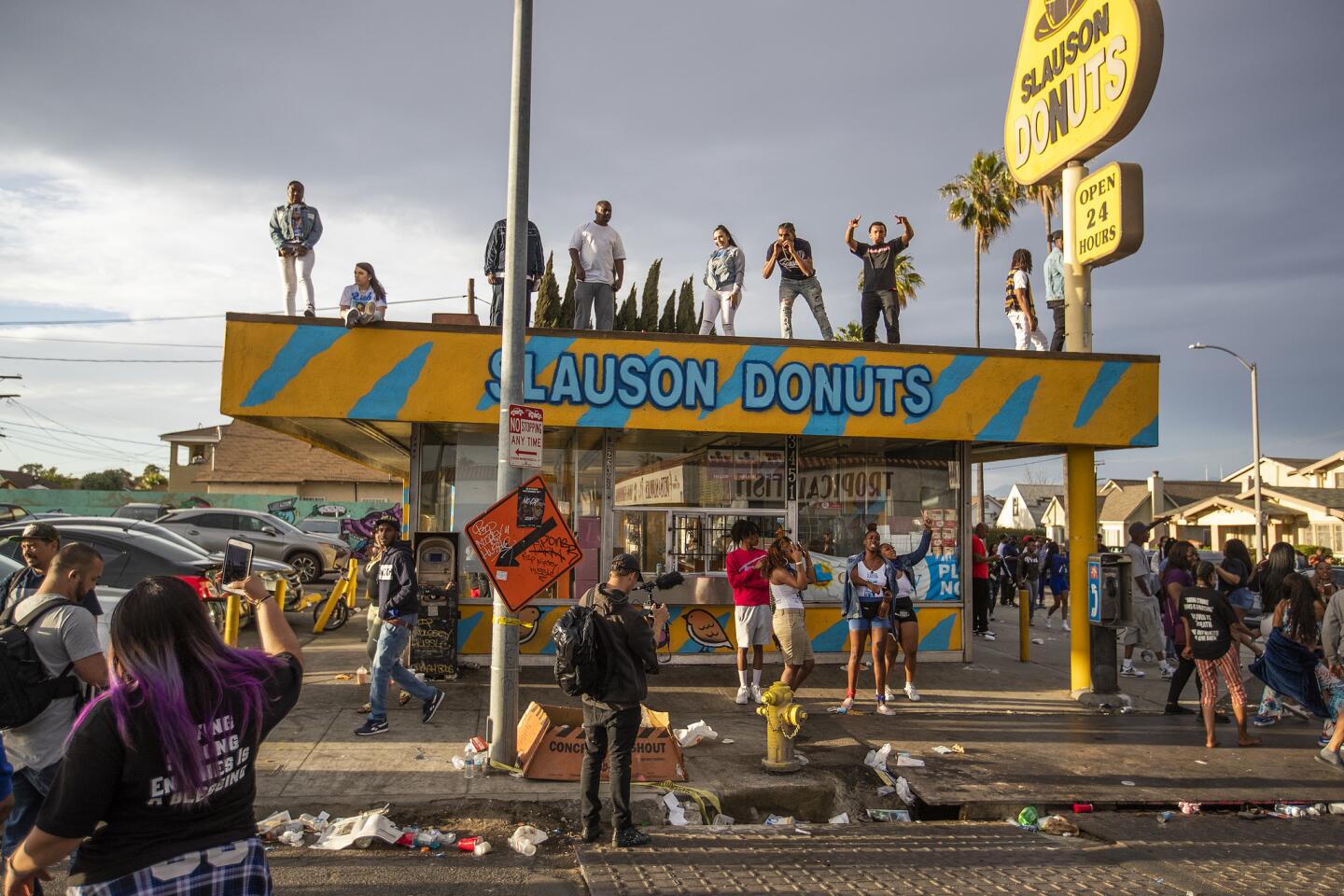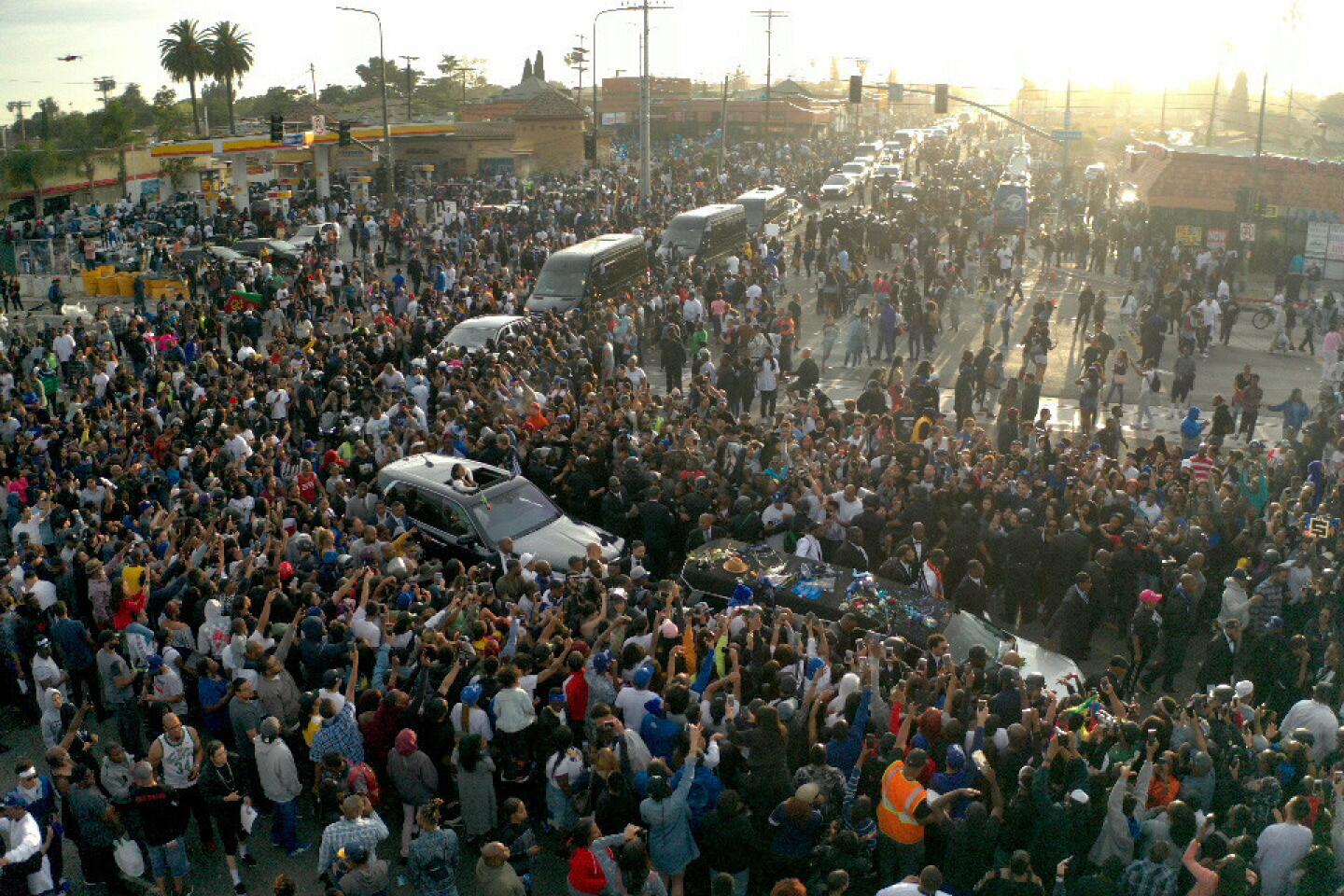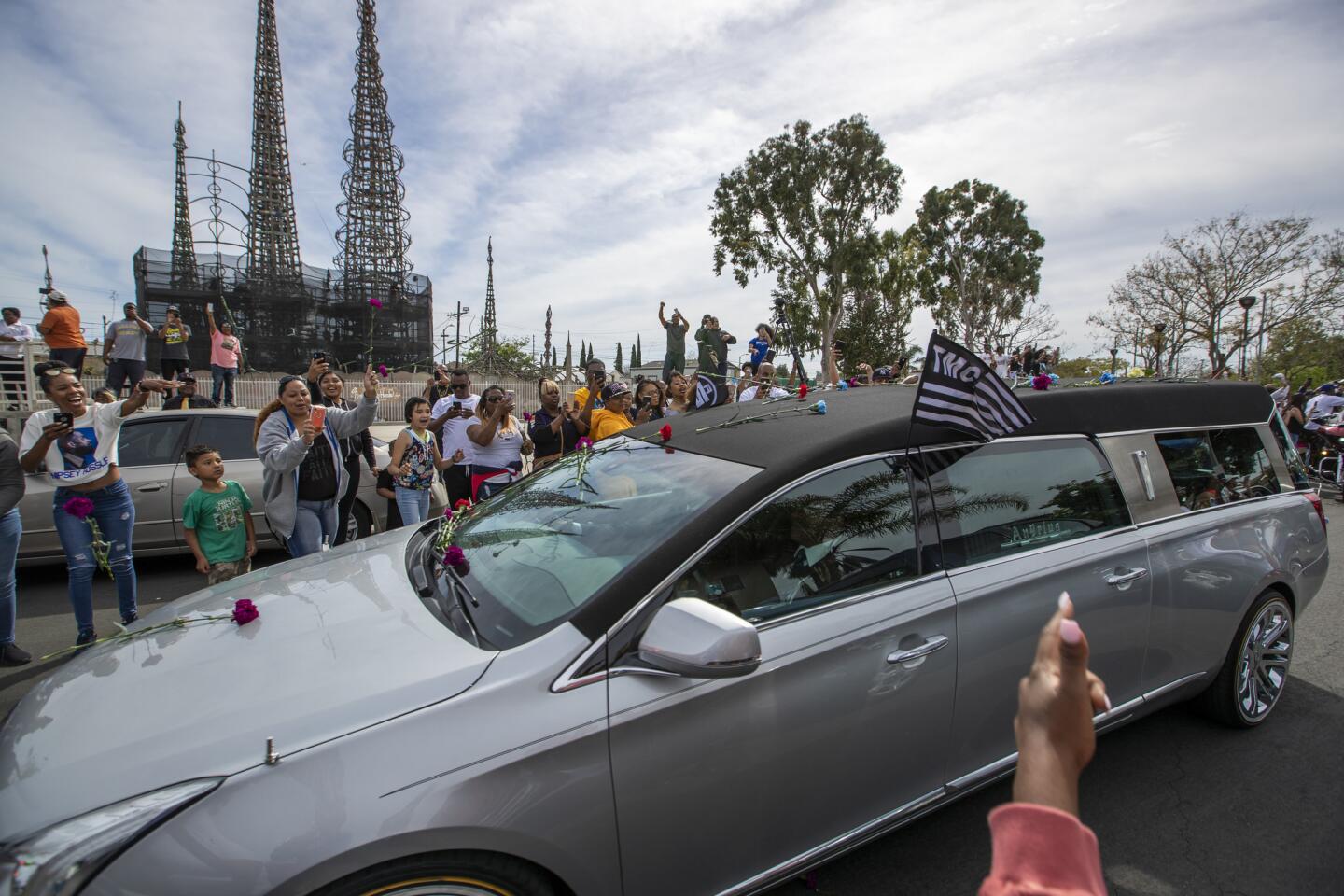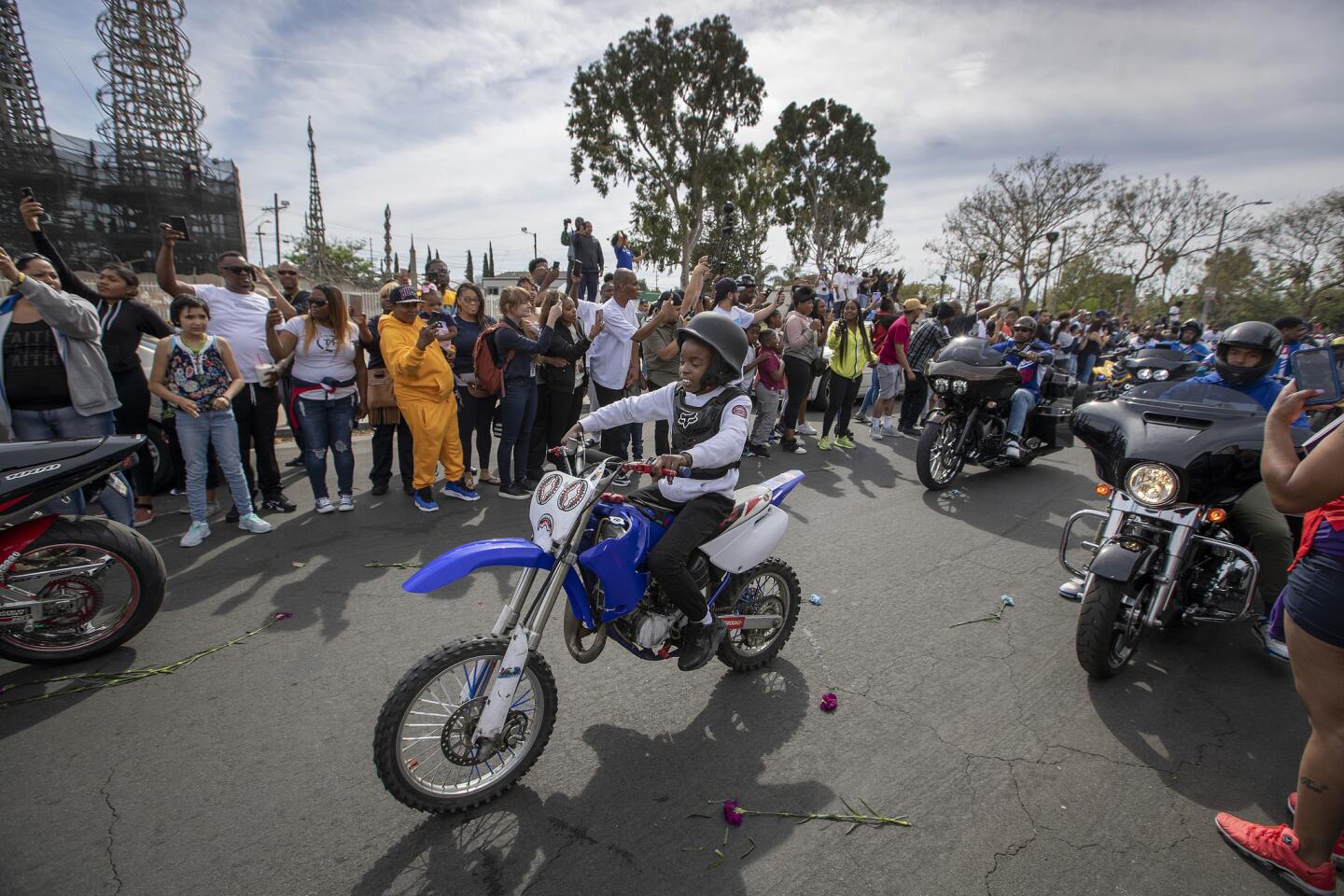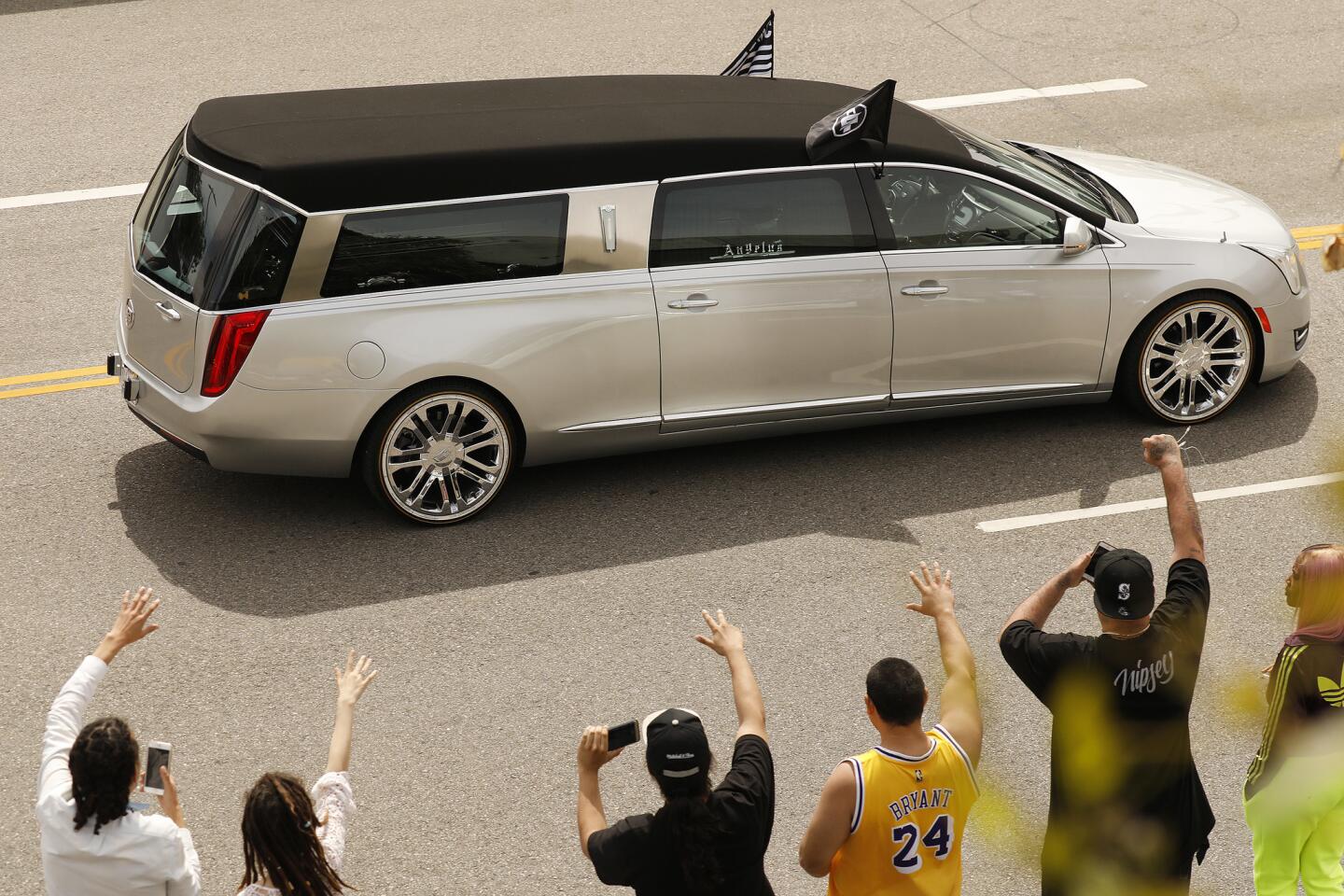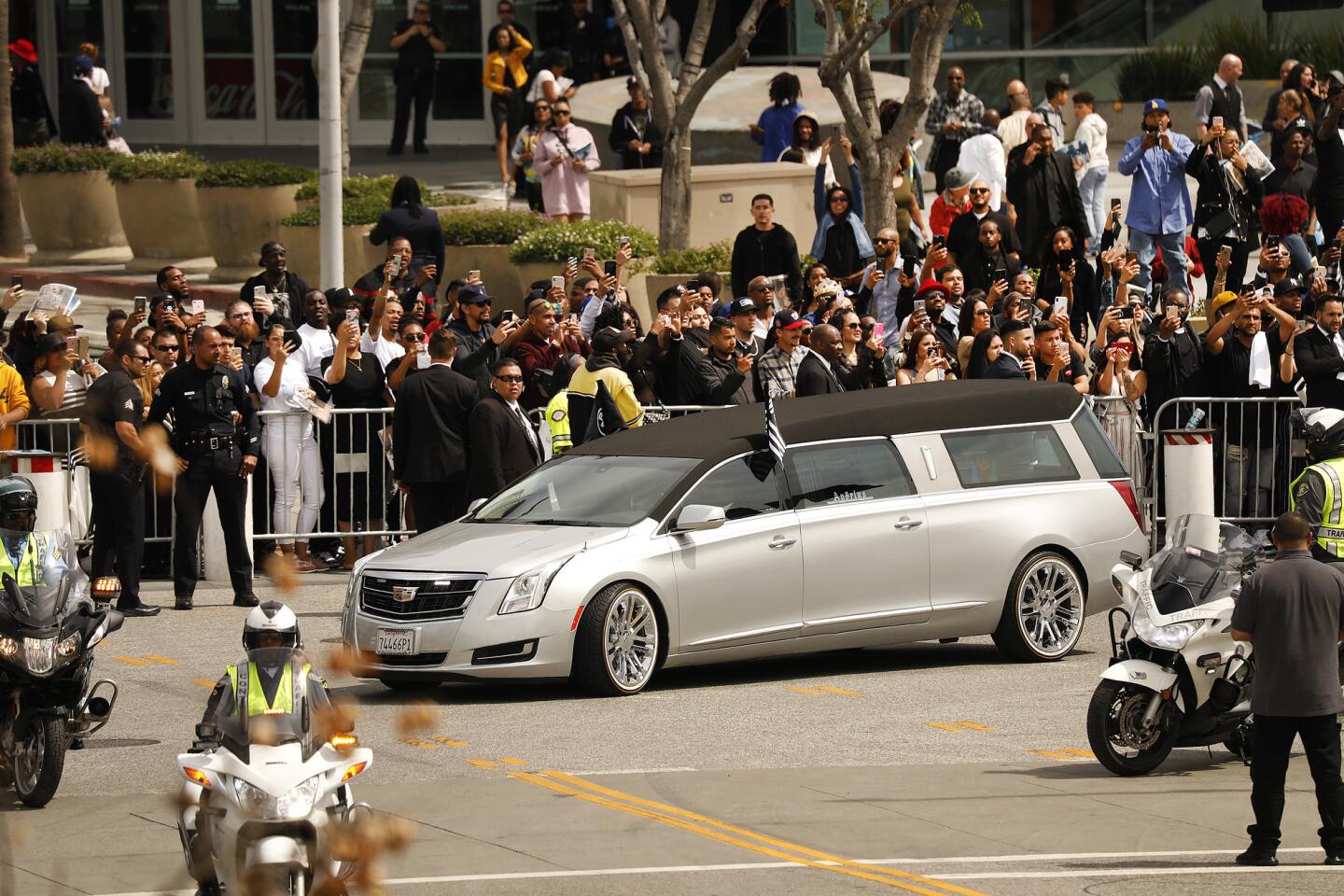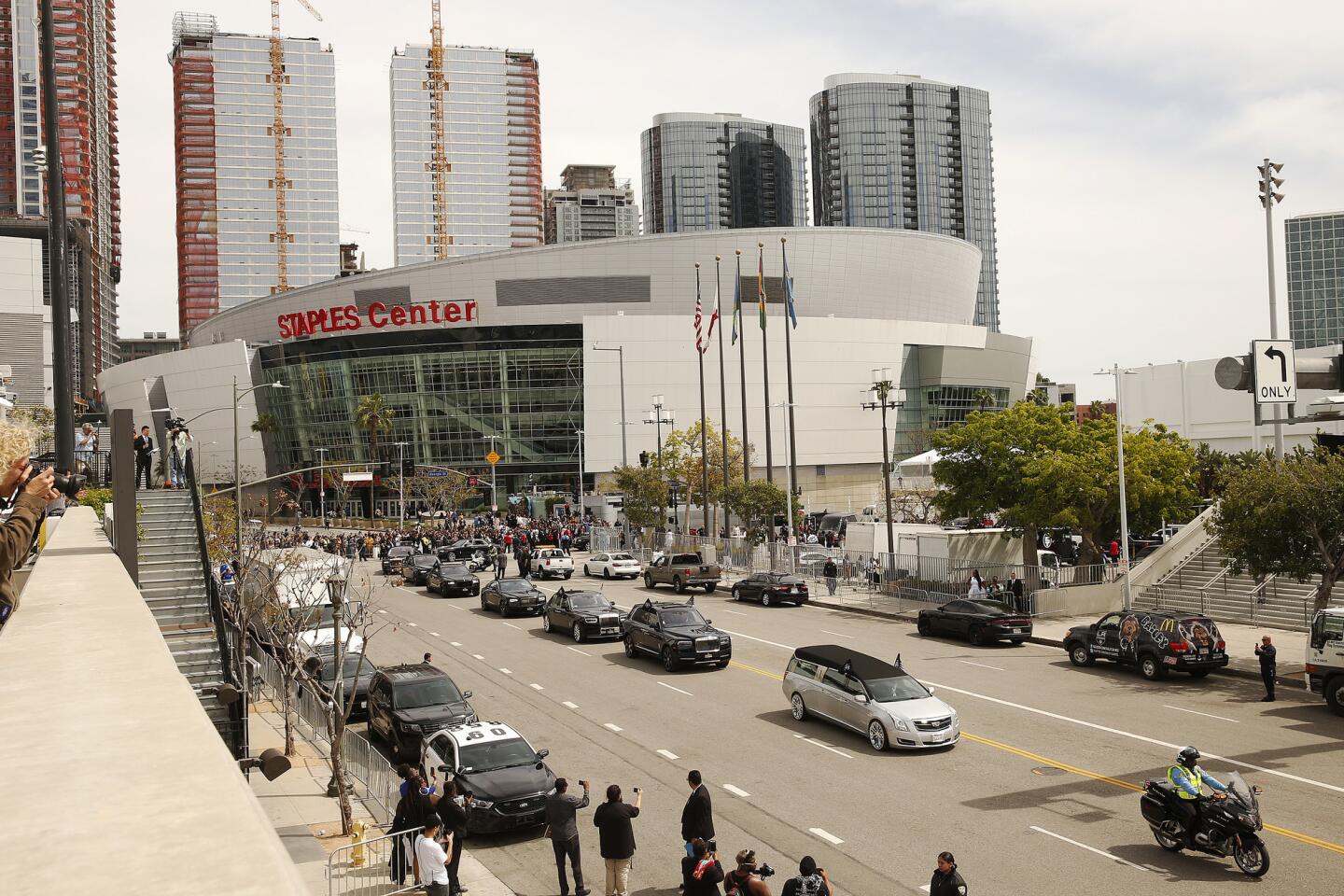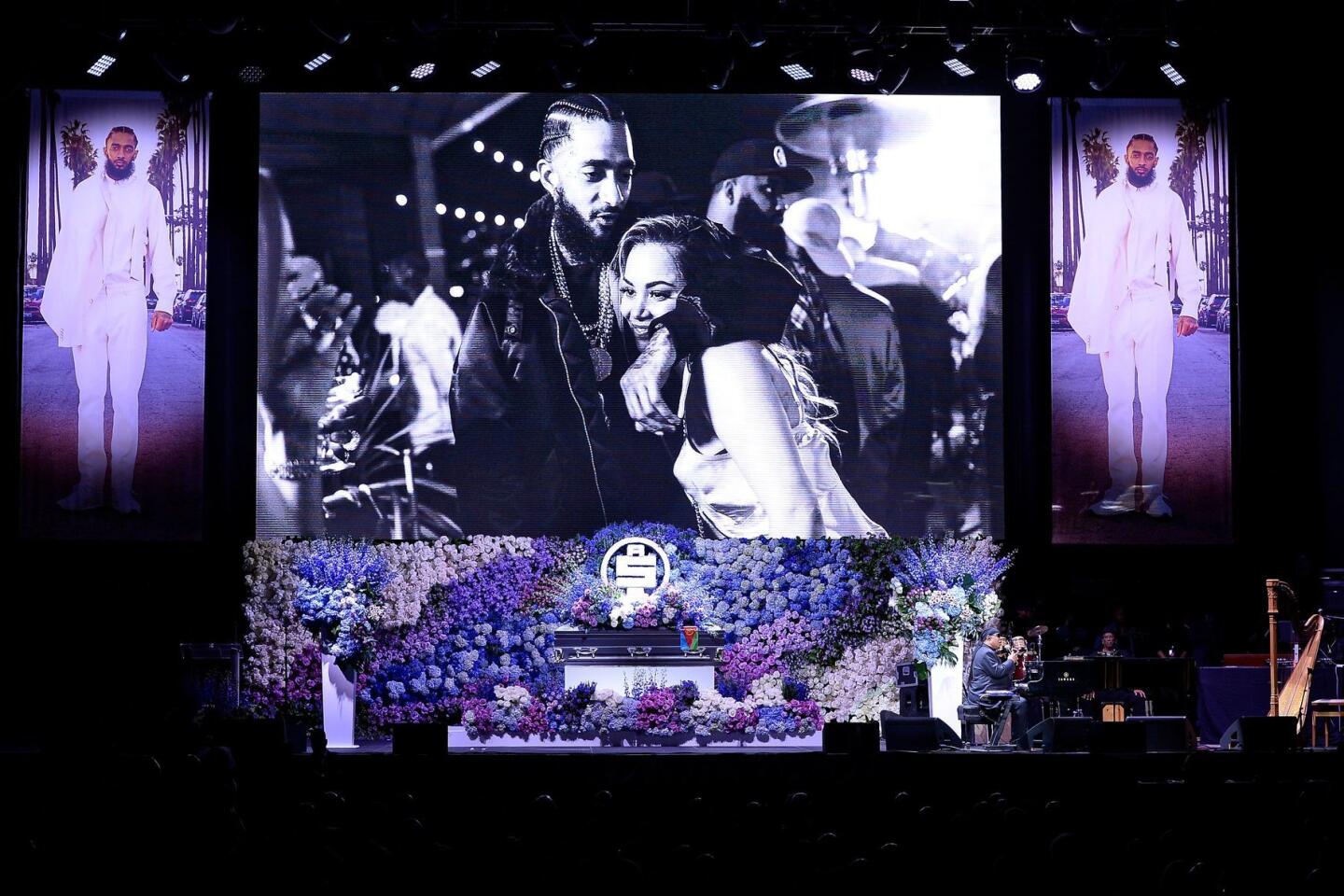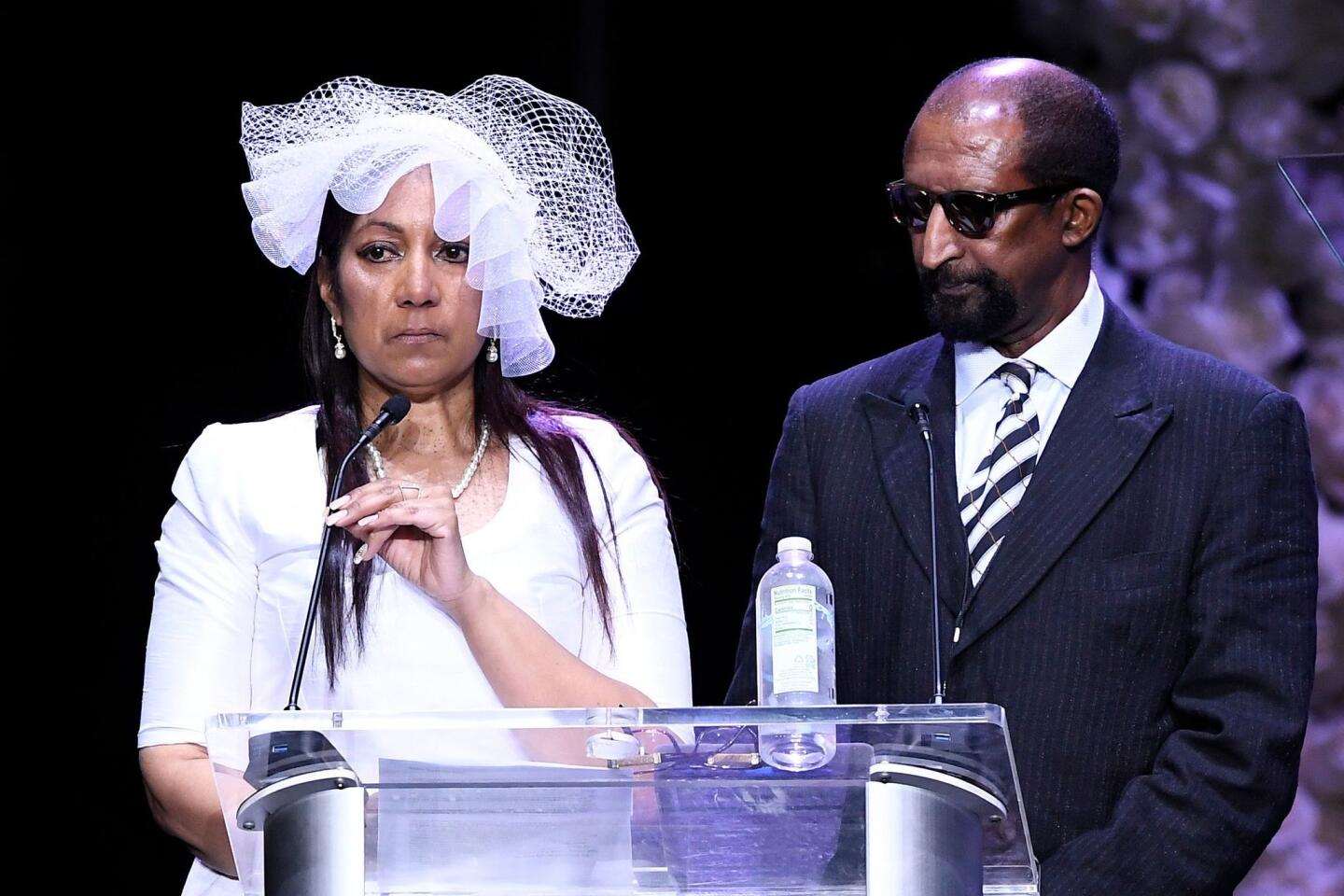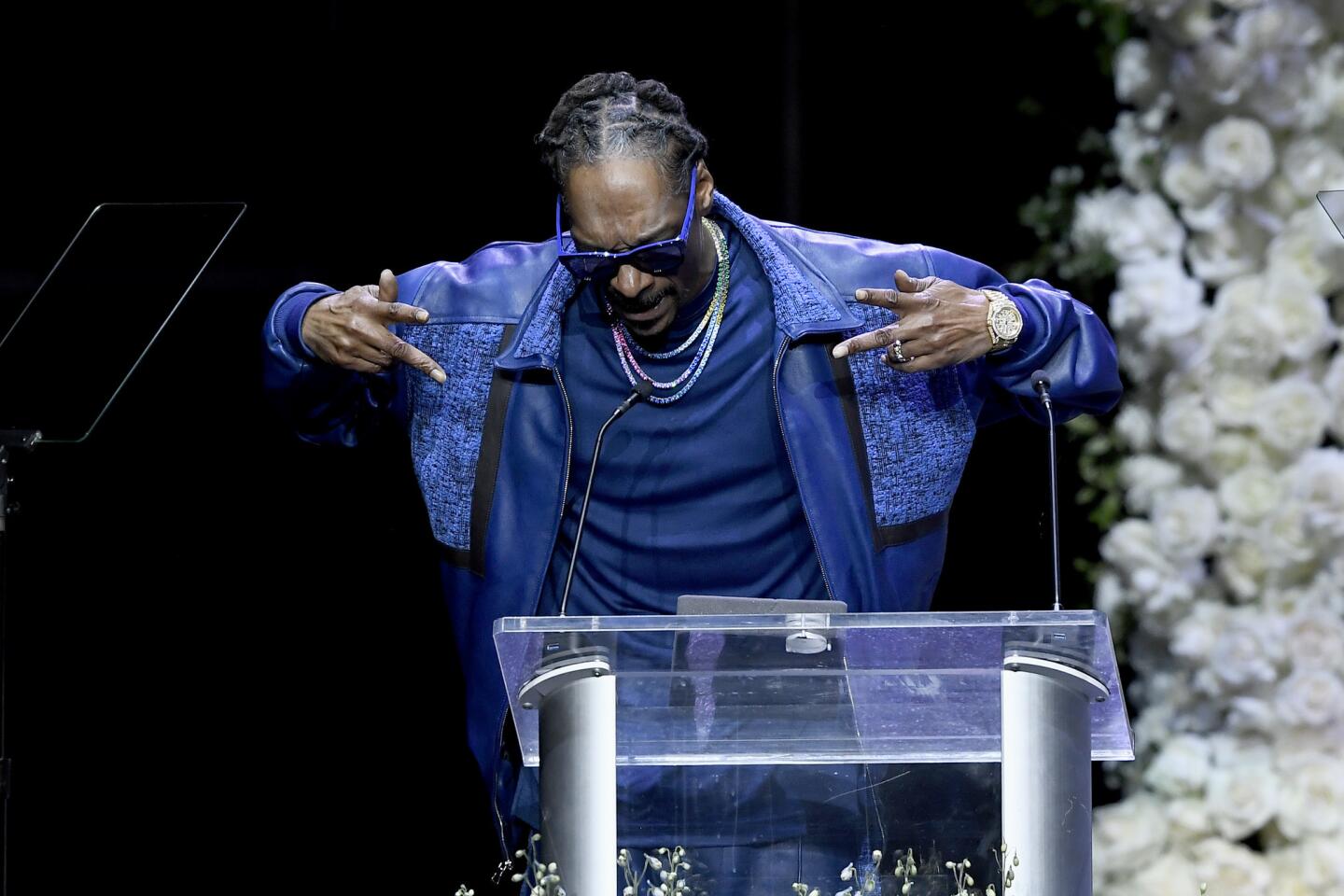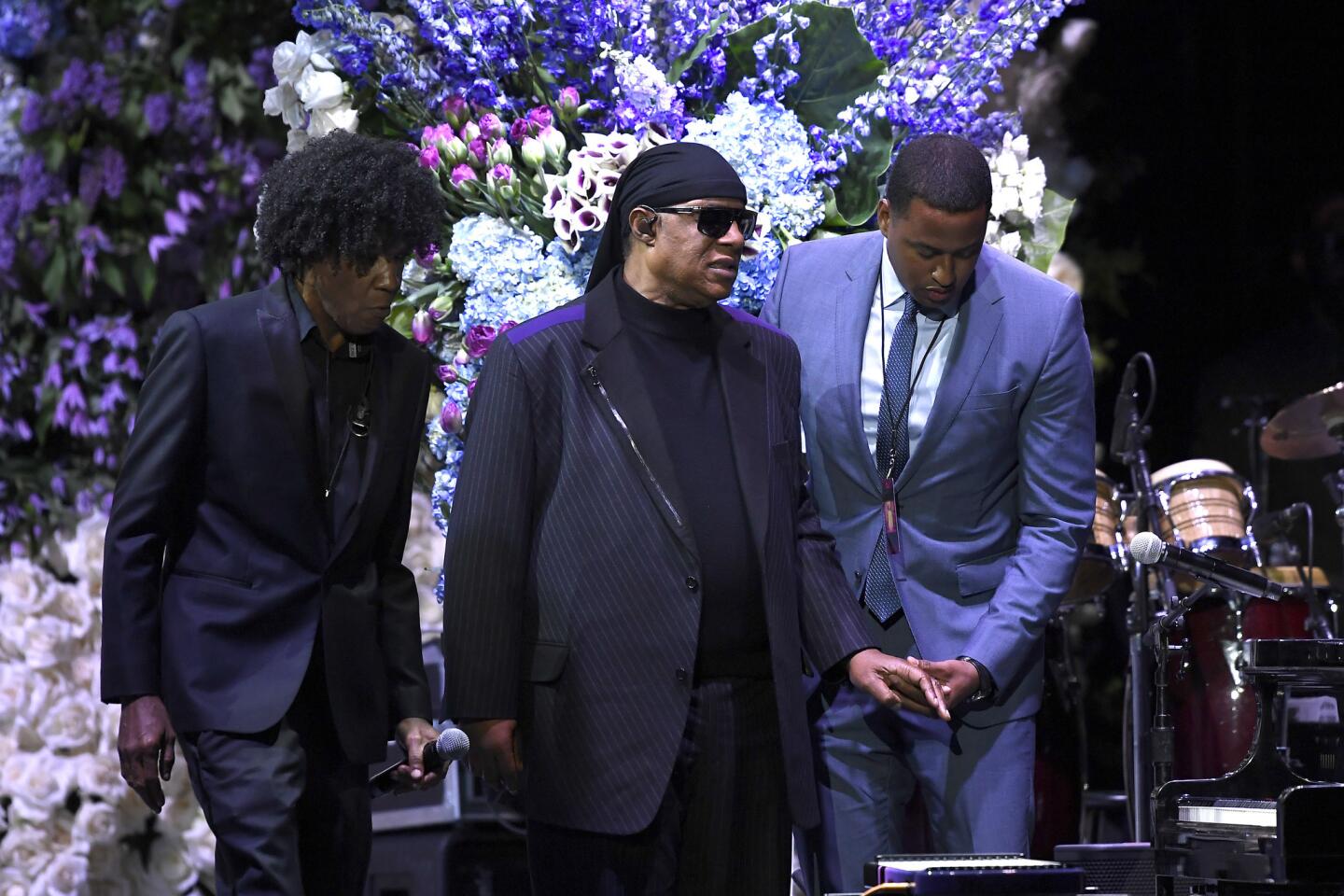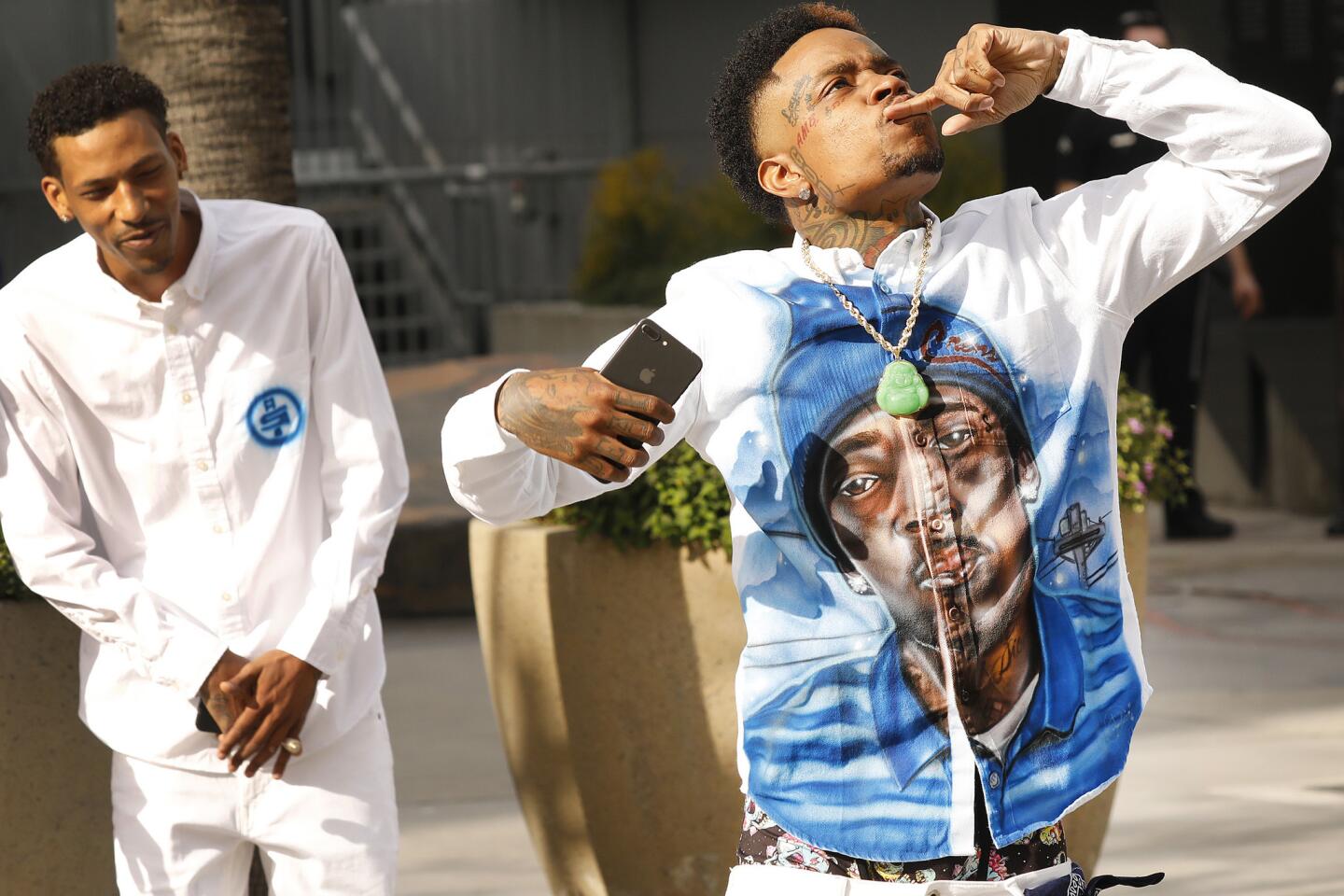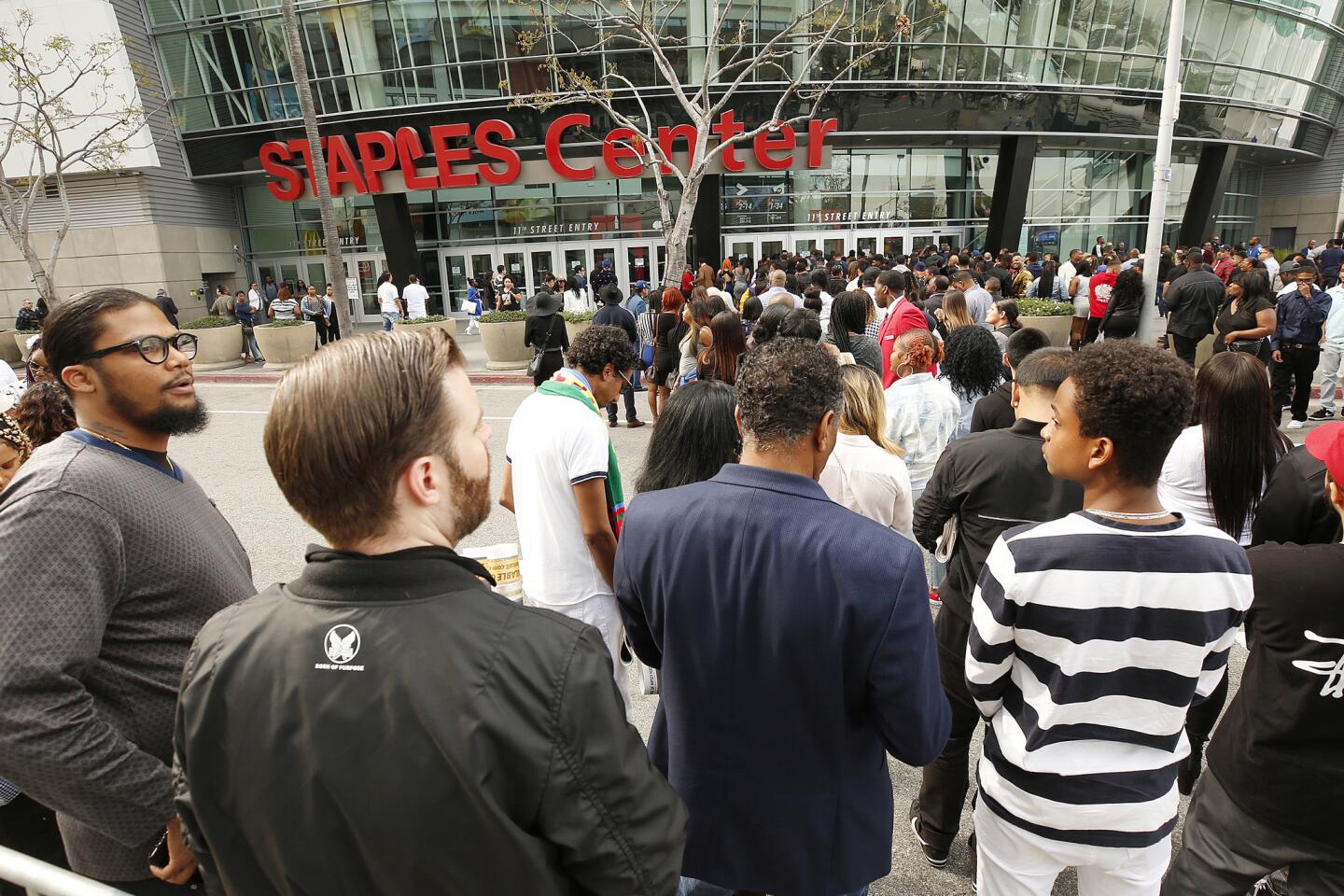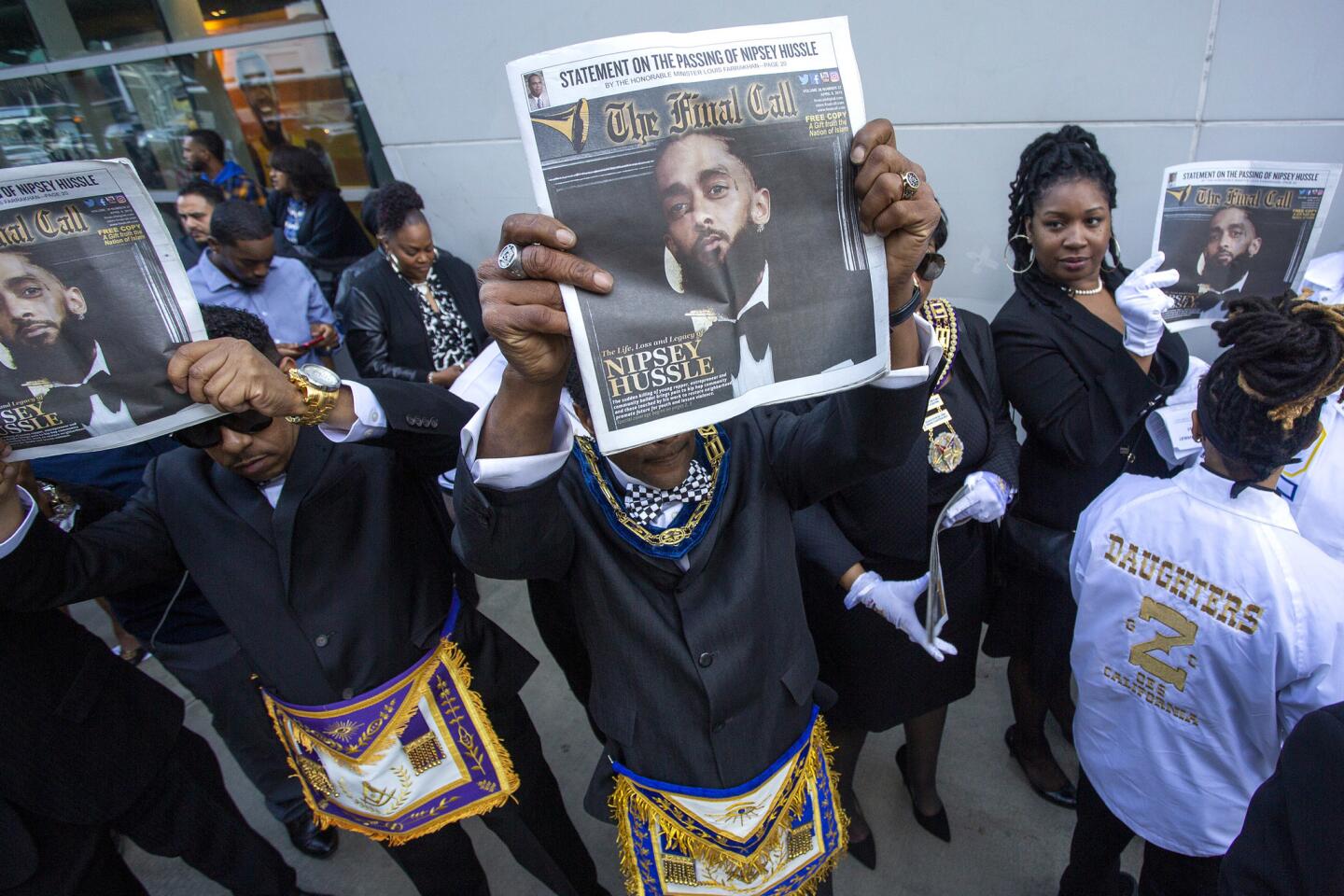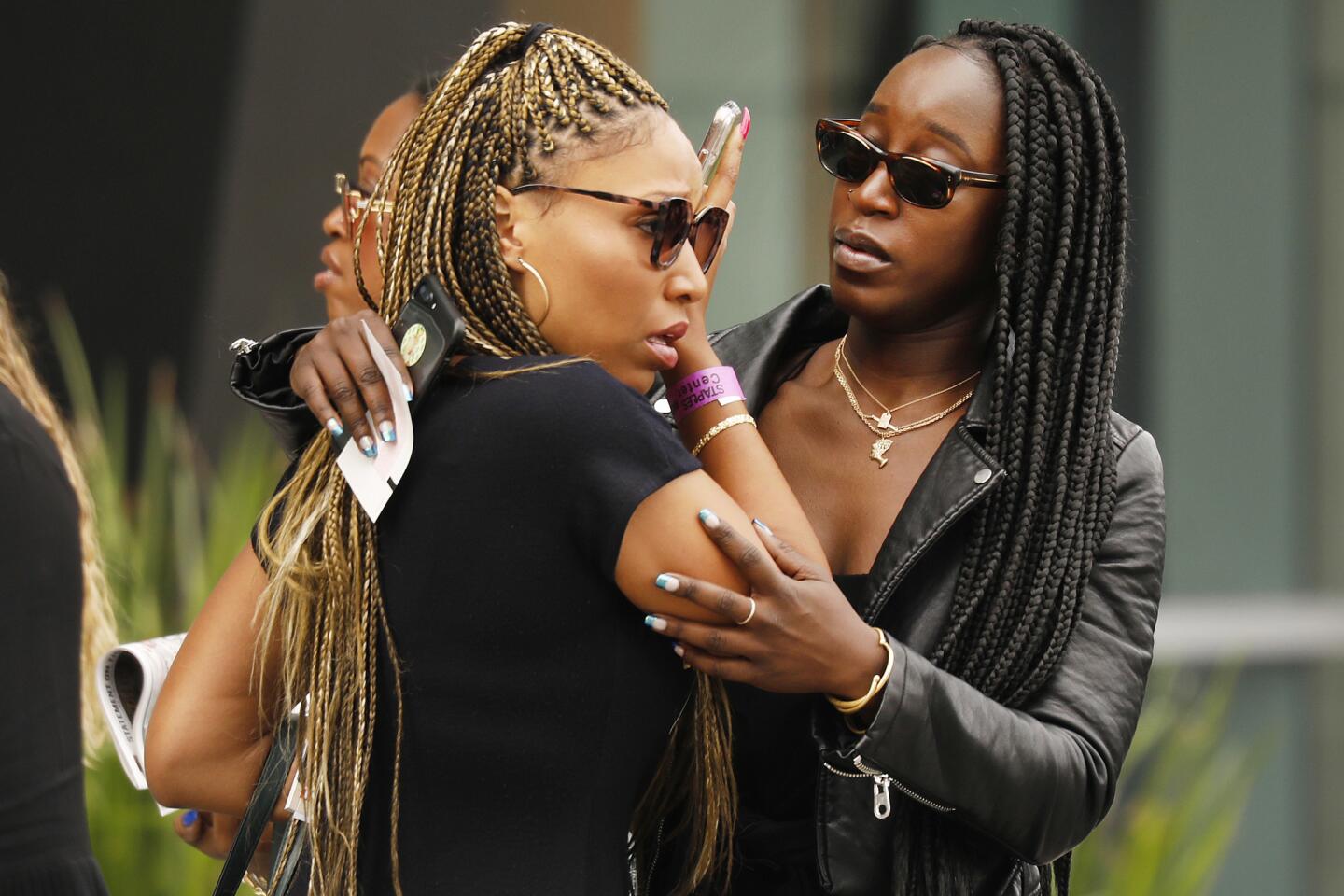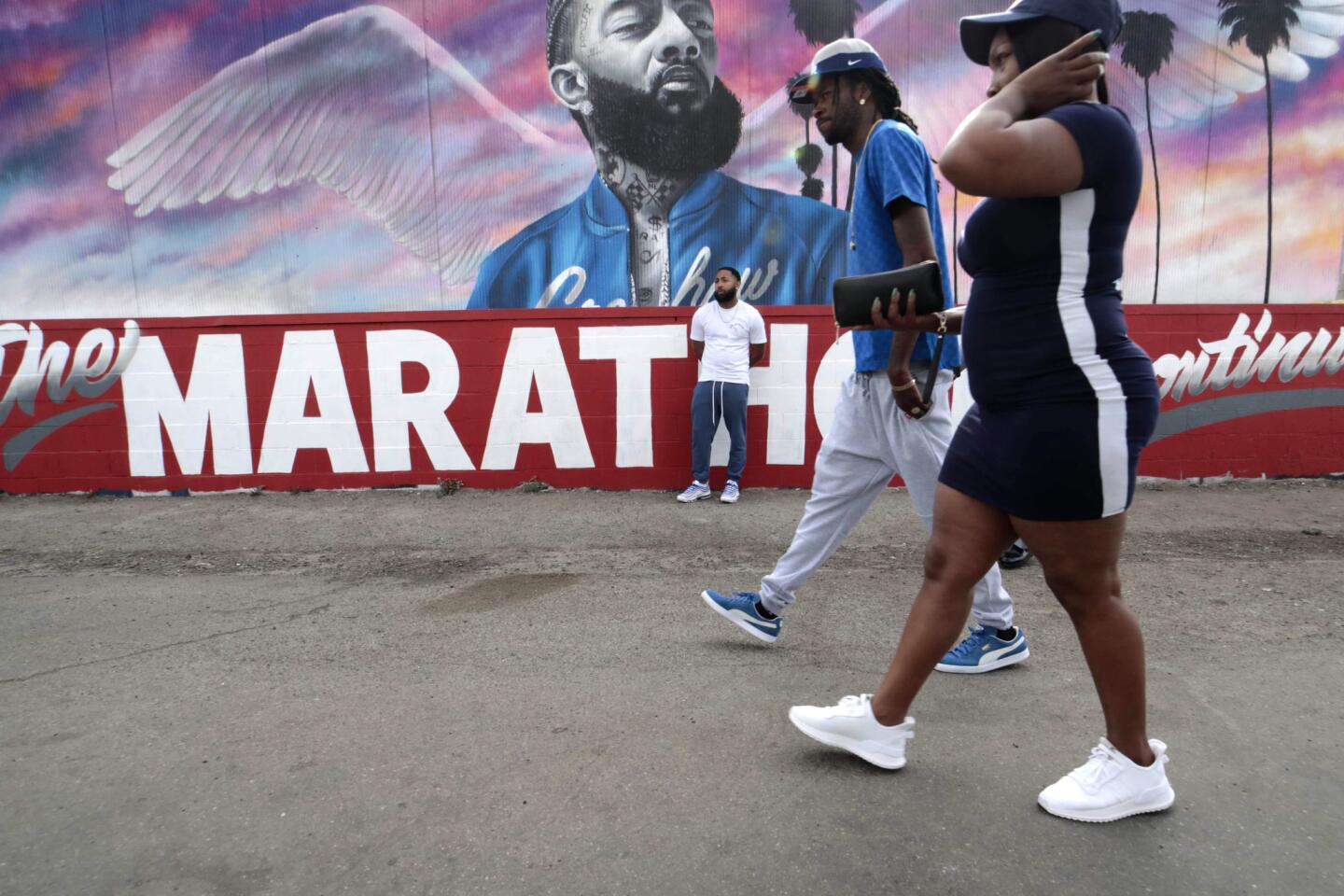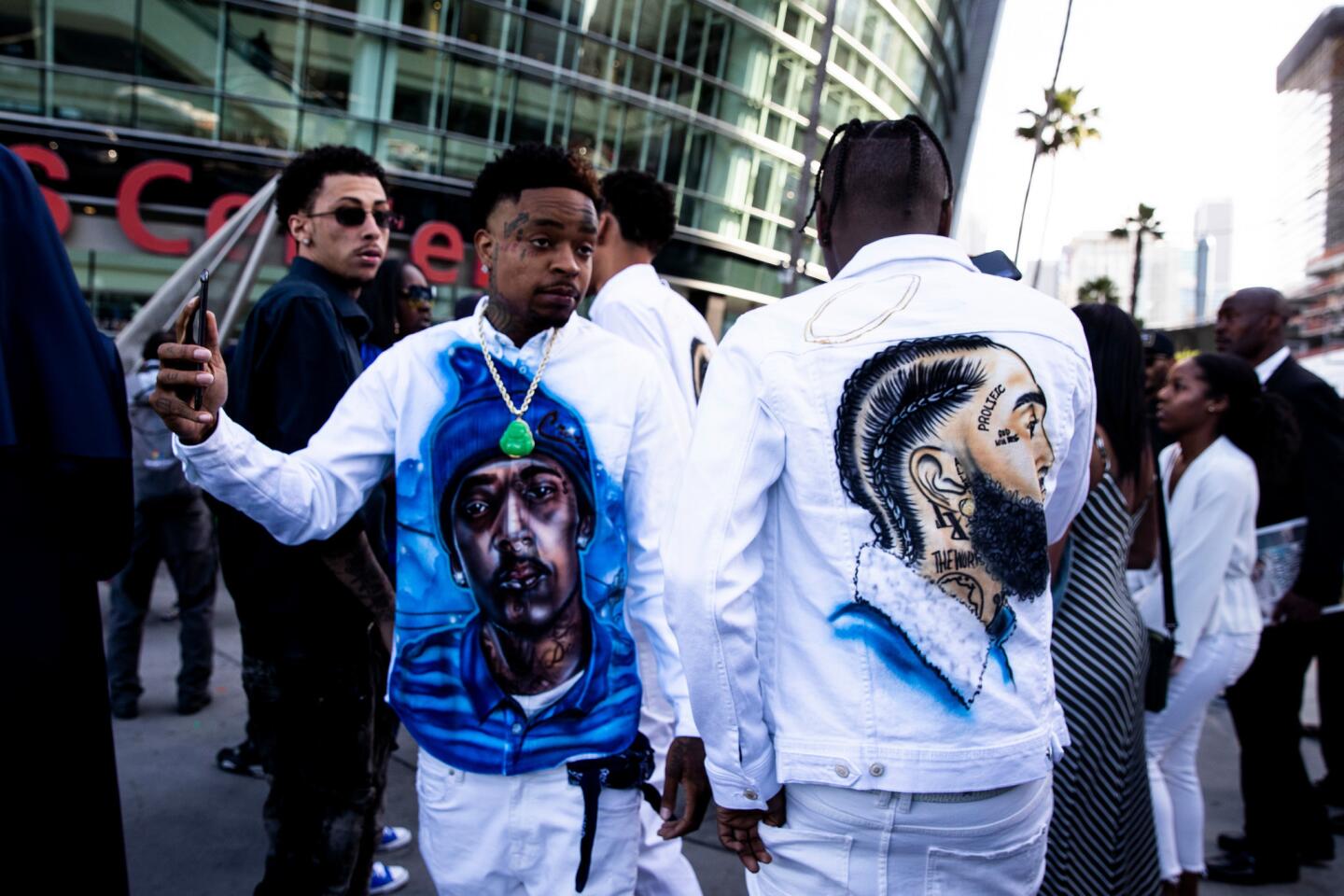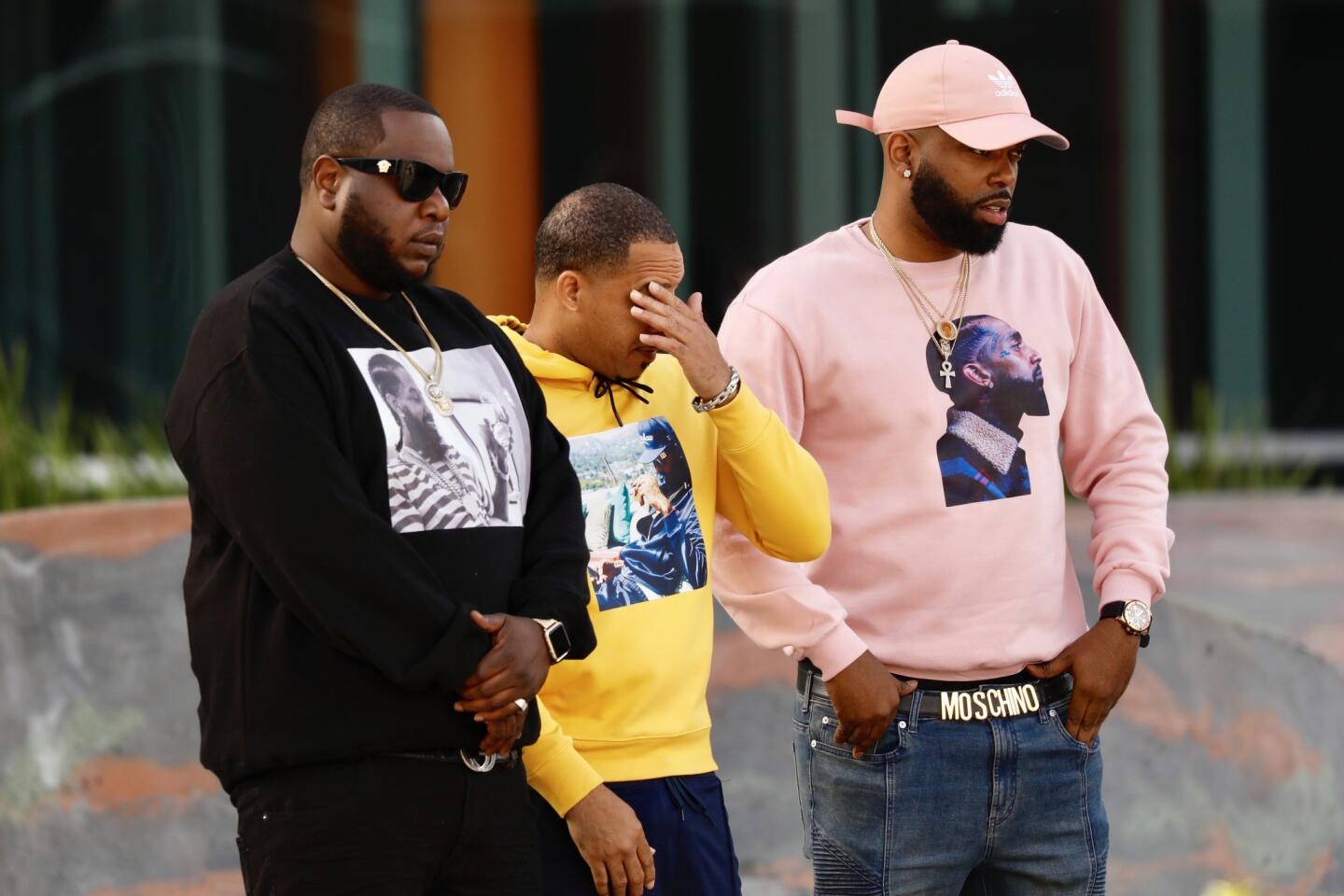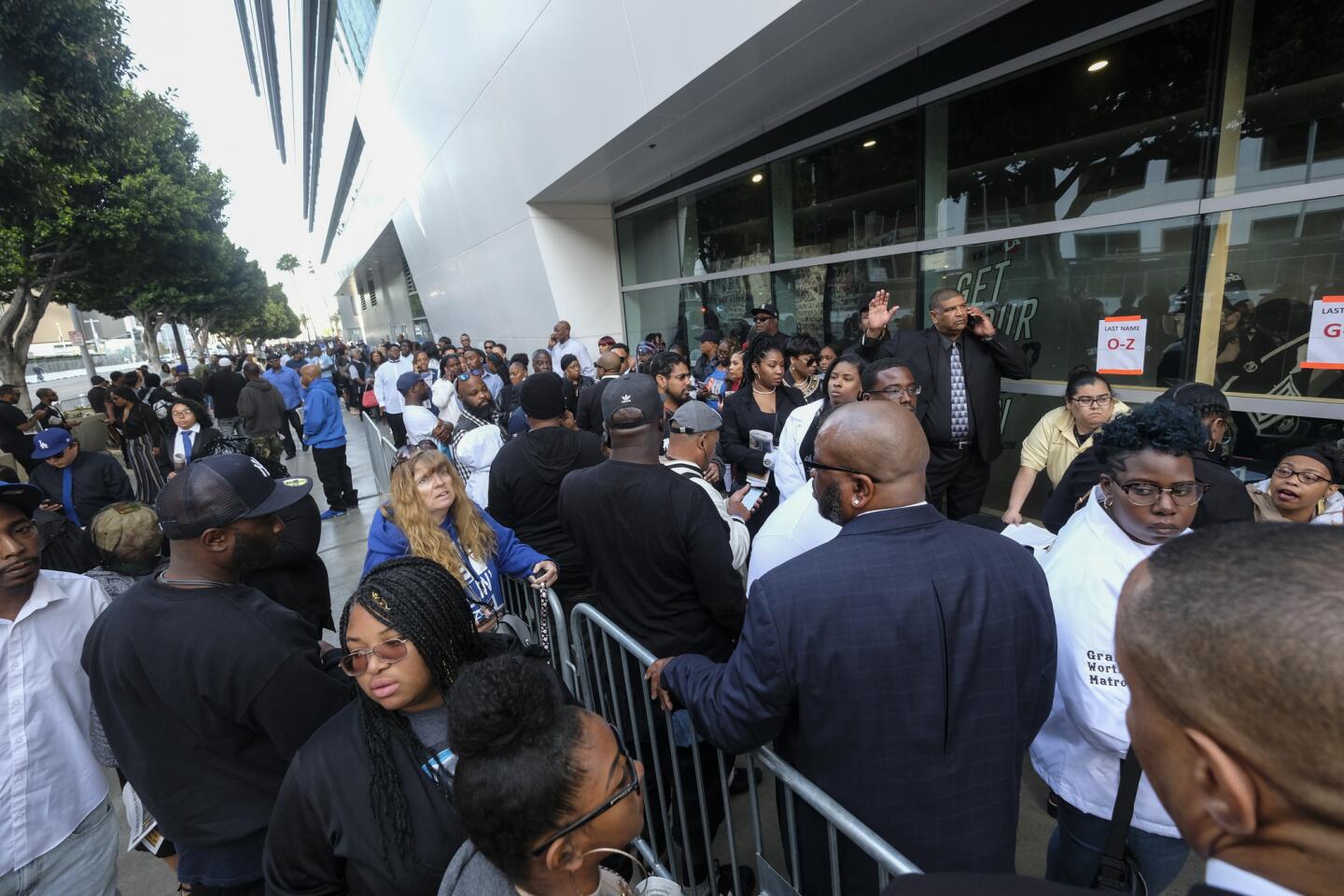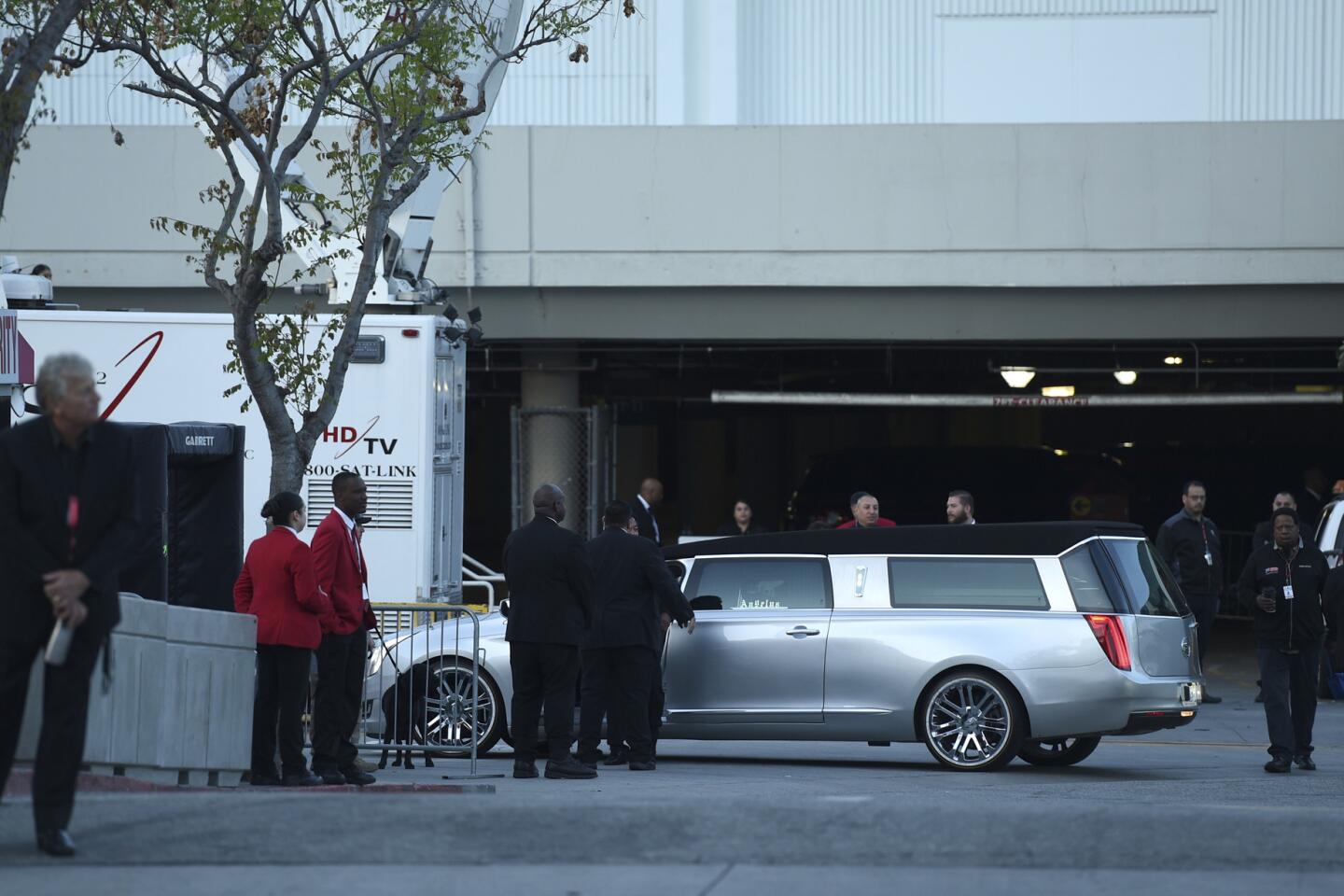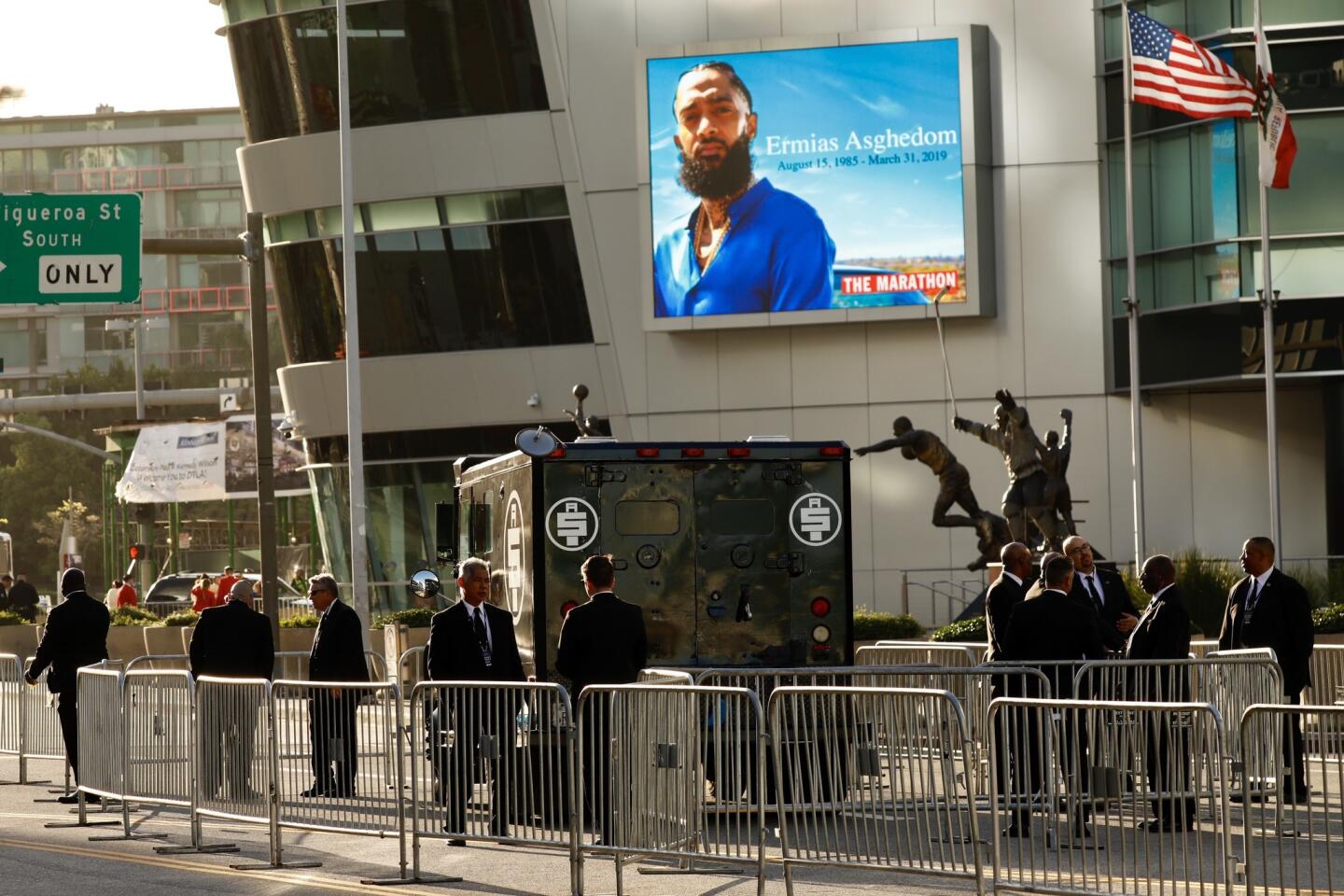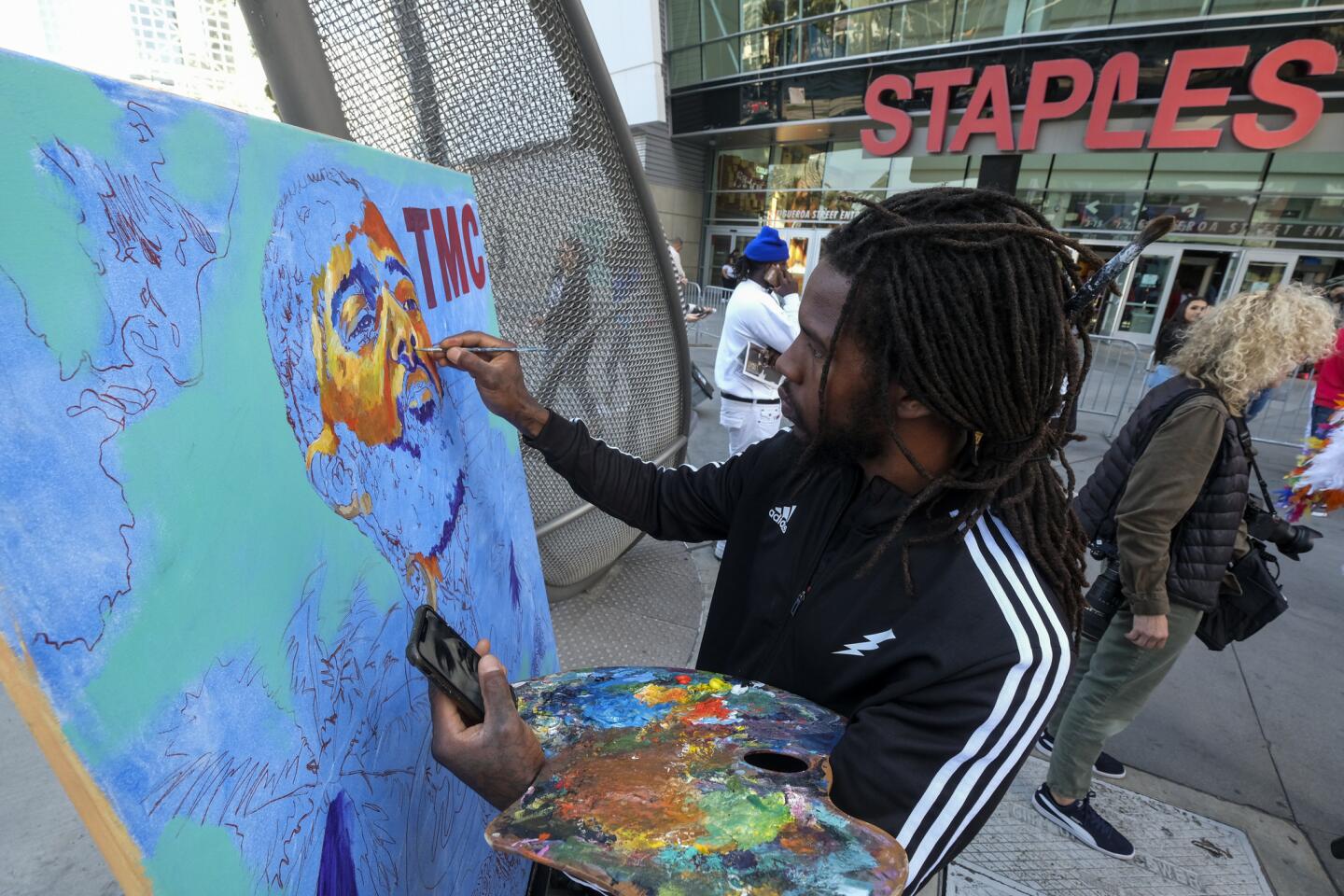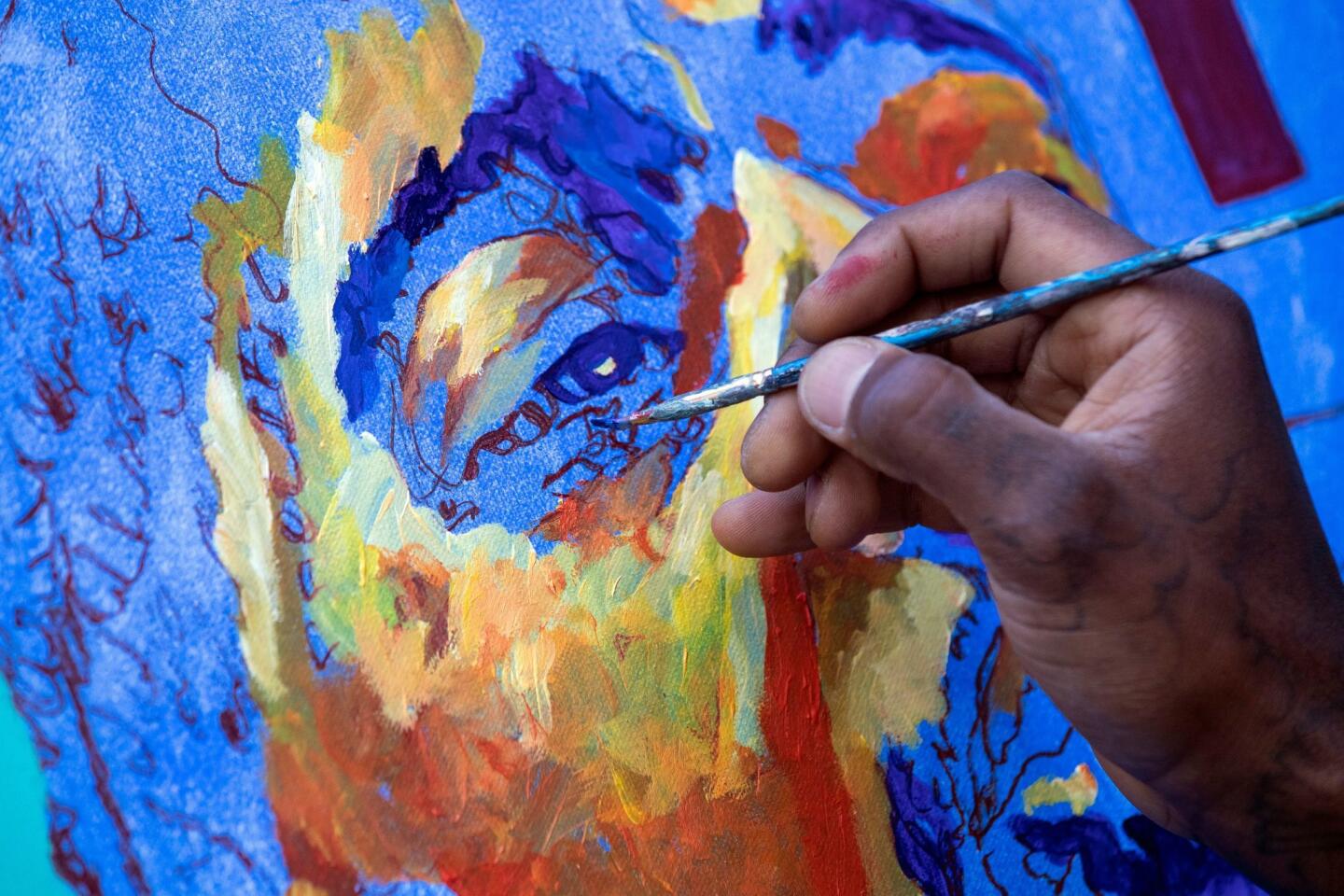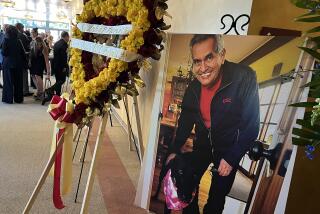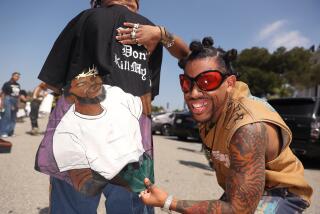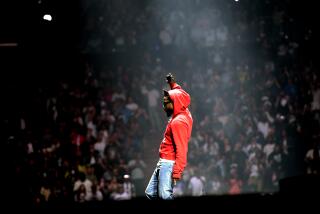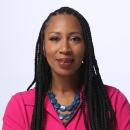Tens of thousands mourn Nipsey Hussle. But his memorial service was all about South L.A.

Nipsey Hussle, the Grammy-nominated rapper, made his final victory lap around Los Angeles on Thursday.
- Share via
Nipsey Hussle, the Grammy-nominated rapper who never abandoned his ’hood, made his final victory lap around Los Angeles on Thursday — a star-studded event that was bathed in blackness.
The family of the 33-year-old, who was shot to death on March 31, gave the rights to stream a three-hour memorial service at Staples Center to Tidal, the streaming music service owned by rap mogul Jay-Z.
Instead of relying solely on Los Angeles police, the family tapped members of the Nation of Islam to handle their personal security and control the crowd along a lengthy procession route through South L.A.
And at the end of this farewell tour, the family put Hussle’s body in the hands of Angelus Funeral Home — a staple of a black-owned business off Crenshaw Boulevard.
Tens of thousands of mourning fans, many of them dressed in blue and white, came out on Thursday to grieve and celebrate the life of Hussle — a beloved hometown hero whose music and community activism reverberated from Los Angeles to his father’s homeland of Eritrea.
“He is the prophetic voice of all in that community,” Minister Louis Farrakhan, the Nation of Islam leader, said to the crowd at Staples Center. “He lived the gang life, but he didn’t stay there. He lived the life of the ’hood, but he rose above the pull of gravity. Ermias was more than a hip-hop artist: He was a voice; he was a brilliant mind, and the spirit of God was in his life.”
Born Ermias Joseph Asghedom, Hussle was gunned down in broad daylight outside his clothing store off Slauson Avenue. Police say it was most likely a personal grudge and not gang ties that led to his death. An acquaintance named Eric Holder has been charged with murder.
Thursday’s daylong tribute to Hussle started with a memorial service at 21,000-seat Staples Center and ended with a 25.5-mile procession through streets lined with people on foot, on motorcycles and doing wheelies on ATVs.
For miles on Thursday afternoon, bystanders lined the streets snapping photos, releasing balloons and throwing flowers at the hearse as it passed. In some places, people climbed utility poles and buildings, including Slauson Donuts, to get a better view. So many mourners flooded the streets that the procession was periodically mired in gridlock. It was an event the likes of which the Los Angeles has never quite seen.
“It was beautiful in its own right,” said Marie Durrah, who grew up on 67th Street and Crenshaw Boulevard, which would later become Hussle’s turf. “Different neighborhoods gathering together to pay homage to someone who did a lot for his community.”
Free tickets for the morning service — attended by a who’s who of black entertainment, including Stevie Wonder and Snoop Dogg — were gone within minutes. The only other time Staples Center was used to memorialize an entertainer was in 2009, when Michael Jackson died.
Hussle, who in his rap lyrics and interviews said that he was part of the Rollin’ 60s Crips gang, had left that lifestyle behind, but he never left his Hyde Park neighborhood or its people, speakers reminded the crowd. He was a frequent face in the L-shaped strip mall that he owned and where he opened the Marathon Clothing store. He hired felons. And he was on a mission to revitalize his struggling neighborhood.
“He put his heart and soul on Crenshaw and Slauson,” said his brother, Samiel Asghedom.
The service began almost an hour late on Thursday morning, as thousands of fans waited in line outside Staples Center. Inside, an image of the slain rapper — bathed in shades of blue — was projected large on a center screen and flanked by identical images of him dressed in all white, with palm trees stretched high in the sky behind him. Fans — some wearing shirts from Hussle’s clothing brand with “Crenshaw” scribbled on the front — filled the cavernous space.
Before speakers climbed onstage, the lights inside were kept dim as the title track from Hussle’s Grammy-nominated album “Victory Lap” played. But the solemn tone quickly transformed into a concert vibe, as people jumped to their feet and erupted in screams. Music blared from speakers and the glare of cellphones illuminated the darkness, as the crowd shouted the slain rapper’s name.
The sea of people pulsed with the music.
The crowd rose to their feet as the DJ shouted, “The victory lap continues,” an homage to Hussle’s motto. If there was any doubt if this was going to be an event of mourning or jubilation, the DJ set the tone and kept shouting “celebration!”
The crowd responded with chants of “Nipsey! Nipsey! Nipsey!”
Throughout the service, family and friends shared touching and often humorous memories of Hussle.

His father, Dawit Asghedom, spoke of how strong his son was, saying how he was born with his umbilical cord around his neck, but pulled through.
Fellow rapper Snoop Dogg recalled how he and Hussle created a bond and a brotherhood over music and entrepreneurship. “He had vision for me that I didn’t even have for myself,” he said.
Kameron Carter — the son of Hussle’s girlfriend, Lauren London, and rapper Lil Wayne — wore a cobalt blue suit and matching tie as he took the stage. His mother, dressed all in white, and Hussle’s children looked on as the boy spoke.
“On the night of April 2, I had a dream. I was in paradise, and I was playing in the ocean water when Ermias popped up right behind me. He said, ‘What up, Killa?’ I turned around and yelled his name and gave him a hug,” Kameron, 9, said. “I realized Ermias told me what heaven was like; he told me it was paradise.”
As they stood onstage, Hussle’s 2-year-old son, Kross Asghedom, grabbed the microphone, put it to his mouth and grinned.
In giving her own eulogy, London said she had “never felt this type of pain before.”
“I know everybody is hurting, but I’d like to say something to my city of Los Angeles,” she concluded after a few minutes. “If you’re from L.A., stand up. This pain is ours. We know what it meant to us. We lost an incredible soul. We lost somebody very rare to us. We lost a real one and we won’t ever be the same but … the marathon continues.”
In perhaps the biggest surprise of the morning, publicist Karen Civil read a letter from a man many in the black community have dubbed their “forever POTUS” — former President Obama.
“While most folks look at the Crenshaw neighborhood where he grew up and see only gangs, bullets, and despair, Nipsey saw potential,” Obama wrote. “He saw hope. He saw a community that, even through its flaws, taught him to always keep going. His choice to invest in that community rather than ignore it … is a legacy worthy of celebration.”

Fans crowded the streets to catch a glimpse of the silver hearse carrying the body of Nipsey Hussle.
In his eulogy, Farrakhan used Hussle’s tragic ending as a rallying cry for rival gang members to honor Hussle and abandon the street life.
“He walked among the blue with a heart full of red, and all the colors in between, because his life was for unity,” he said. “His homecoming will be a life call for us to get up from where we are and be a new man and new woman.”
Later, Hussle’s body, carried in a silver hearse, made its way down Vermont Avenue to Watts, where Nipsey spent some of his formative years and honed his craft at the Watts Towers Arts Center, and through Inglewood, through Hyde Park and finally up Crenshaw to the funeral home.
The procession was quintessentially L.A., full of flashy cars performing show-offy maneuvers. At 49th Street, a low rider car tilted onto one side. Other cars sped and swerved as passengers dangled precariously out of open windows, some waving programs from the memorial service.
Deja Peña, of Whittier, said she grew up in South L.A. and came back to Crenshaw and Slauson Avenue because Hussle was a good man who worked hard to lift up his community.
“He came from the gutter like us and went places,” she said. “With all the stores he owns on this block, he helped people here get jobs. He made it big.”
Times staff writers Hannah Fry, Cindy Chang, Julia Wick, Alexa Diaz, Richard Winton, Alejandra Reyes-Velarde and Jaclyn Cosgrove contributed to this report.
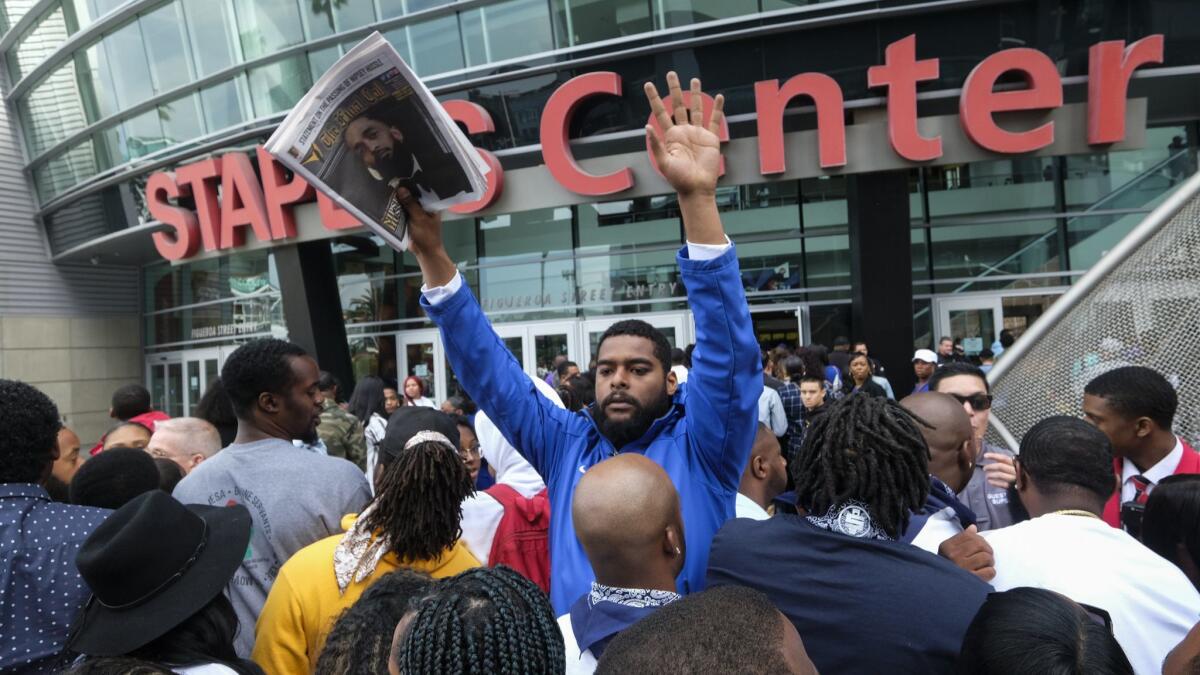
For more California breaking news, follow @AngelJennings. She can also be reached at [email protected].
More to Read
Sign up for Essential California
The most important California stories and recommendations in your inbox every morning.
You may occasionally receive promotional content from the Los Angeles Times.
